Subclass: Theria



( Caluromys species)



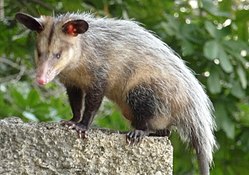


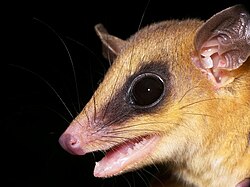

( Marmosa species)

(Marmosa ( Micoureus ) species)





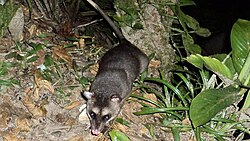

Infraclass: Metatheria
The infraclass Metatheria includes all living and extinct marsupials, but also includes some related extinct orders of mammals that are no longer considered marsupials, such as Sparassodonta. At least six families of sparassodonts lived in South America prior to the interchange, dominating the niches for large mammalian carnivores.
Marsupials are a collection of pouched mammals that was once more widely distributed. Today they are found primarily in isolated or formerly isolated continents of Gondwanan origin. South America's 22 extant genera compares with 10 in Central America, 1 in North America north of Mexico, 52 in Australia, 28 in New Guinea and 2 in Sulawesi. South American marsupials are thought to be ancestral to those of Australasia. [7]
Superorder: Ameridelphia
Order: Didelphimorphia (common opossums)
Didelphimorphia is the order of common opossums of the Western Hemisphere. Opossums probably diverged from the basic South American marsupials in the late Cretaceous or early Paleocene. They are small to medium-sized marsupials, about the size of a large house cat, with a long snout and prehensile tail.
- Family: Didelphidae (American opossums)
- Subfamily: Caluromyinae
- Genus: Caluromys
- Derby's woolly opossum, C. derbianus LC
- Brown-eared woolly opossum, C. lanatus LC
- Bare-tailed woolly opossum, C. philander LC
- Genus: Caluromysiops
- Black-shouldered opossum, Caluromysiops irrupta LC
- Genus: Caluromys
- Subfamily: Glironiinae
- Genus: Glironia
- Bushy-tailed opossum, Glironia venusta LC
- Genus: Glironia
- Subfamily: Hyladelphinae
- Genus: Hyladelphys
- Kalinowski's mouse opossum, Hyladelphys kalinowskii LC
- Genus: Hyladelphys
- Subfamily: Didelphinae
- Genus Chacodelphys
- Chacoan pygmy opossum, Chacodelphys formosaVU
- Genus: Chironectes
- Water opossum, Chironectes minimus LC
- Genus Cryptonanus
- Agricola's gracile opossum, Cryptonanus agricolaiDD
- Chacoan gracile opossum, Cryptonanus chacoensis LC
- Guahiba gracile opossum, Cryptonanus guahybaeDD
- Unduavi gracile opossum, Cryptonanus unduaviensisDD
- Genus: Didelphis
- White-eared opossum, Didelphis albiventris LC
- Big-eared opossum, Didelphis aurita LC
- Guianan white-eared opossum, Didelphis imperfecta LC
- Common opossum, Didelphis marsupialis LC
- Andean white-eared opossum, Didelphis pernigra LC
- Genus: Gracilinanus
- Aceramarca gracile opossum, Gracilinanus aceramarcae LC
- Agile gracile opossum, Gracilinanus agilis LC
- Wood sprite gracile opossum, Gracilinanus dryasNT
- Emilia's gracile opossum, Gracilinanus emiliaeDD
- Northern gracile opossum, Gracilinanus marica LC
- Brazilian gracile opossum, Gracilinanus microtarsus LC
- Genus: Lestodelphys
- Patagonian opossum, Lestodelphys halli LC
- Genus: Lutreolina
- Big lutrine opossum, Lutreolina crassicaudata LC
- Massoia's lutrine opossum, Lutreolina massoia LC
- Genus: Marmosa
- Subgenus: Eomarmosa
- Red mouse opossum, Marmosa rubraDD
- Subgenus: Exulomarmosa
- Isthmian mouse opossum, Marmosa isthmica
- Robinson's mouse opossum, Marmosa robinsoni LC
- Marmosa simonsi
- Guajira mouse opossum, Marmosa xerophilaVU
- Marmosa zeledoni
- Subgenus: Marmosa
- Quechuan mouse opossum, Marmosa macrotarsus LC
- Linnaeus's mouse opossum, Marmosa murina LC
- Tyler's mouse opossum, Marmosa tylerianaDD
- Marmosa waterhousei
- Subgenus: Micoureus
- Alston's mouse opossum, Marmosa alstoni LC
- White-bellied woolly mouse opossum, Marmosa constantiae LC
- Woolly mouse opossum, Marmosa demerarae LC
- Tate's woolly mouse opossum, Marmosa paraguayana LC
- Little woolly mouse opossum, Marmosa phaeaVU
- Bare-tailed woolly mouse opossum, Marmosa regina LC
- Subgenus: Stegomarmosa
- Heavy-browed mouse opossum, Marmosa andersoniDD
- Rufous mouse opossum, Marmosa lepida LC
- Subgenus: Eomarmosa
- Genus: Marmosops
- Bishop's slender opossum, Marmosops bishopi LC
- Marmosops caucae
- Narrow-headed slender opossum, Marmosops cracensDD
- Creighton's slender opossum, Marmosops creightoniDD
- Dusky slender opossum, Marmosops fuscatusDD
- Handley's slender opossum, Marmosops handleyiCR
- Tschudi's slender opossum, Marmosops impavidus LC
- Gray slender opossum, Marmosops incanus LC
- Junin slender opossum, Marmosops juninensisVU
- Neblina slender opossum, Marmosops neblina LC
- White-bellied slender opossum, Marmosops noctivagus LC
- Dorothy's slender opossum, Marmosops ocellatus LC
- Delicate slender opossum, Marmosops parvidens LC
- Brazilian slender opossum, Marmosops paulensis LC
- Pinheiro's slender opossum, Marmosops pinheiroi LC
- Genus: Metachirus
- Brown four-eyed opossum, Metachirus nudicaudatus LC
- Genus: Monodelphis
- Sepia short-tailed opossum, Monodelphis adusta LC
- Northern three-striped opossum, Monodelphis americana LC
- Monodelphis arlindoi
- Northern red-sided opossum, Monodelphis brevicaudata LC
- Yellow-sided opossum, Monodelphis dimidiata LC
- Gray short-tailed opossum, Monodelphis domestica LC
- Emilia's short-tailed opossum, Monodelphis emiliae LC
- Monodelphis gardneri
- Amazonian red-sided opossum, Monodelphis glirina LC
- Monodelphis handleyi
- Ihering's three-striped opossum, Monodelphis iheringiDD
- Pygmy short-tailed opossum, Monodelphis kunsi LC
- Marajó short-tailed opossum, Monodelphis maraxinaDD
- Osgood's short-tailed opossum, Monodelphis osgoodi LC
- Hooded red-sided opossum, Monodelphis palliolata LC
- Monodelphis peruviana
- Reig's opossum, Monodelphis reigiVU
- Ronald's opossum, Monodelphis ronaldi LC
- Chestnut-striped opossum, Monodelphis rubidaDD
- Monodelphis sanctaerosae
- Long-nosed short-tailed opossum, Monodelphis scalops LC
- Southern red-sided opossum, Monodelphis sorex LC
- Southern three-striped opossum, Monodelphis theresaDD
- Monodelphis touan
- Red three-striped opossum, Monodelphis umbristriataVU
- One-striped opossum, Monodelphis unistriataDD
- Genus: Philander
- Anderson's four-eyed opossum, Philander andersoni LC
- Deltaic four-eyed opossum, Philander deltae LC
- Southeastern four-eyed opossum, Philander frenata LC
- McIlhenny's four-eyed opossum, Philander mcilhennyi LC
- Mondolfi's four-eyed opossum, Philander mondolfii LC
- Olrog's four-eyed opossum, Philander olrogi
- Gray four-eyed opossum, Philander opossum LC
- Genus: Thylamys
- Cinderella fat-tailed mouse opossum, Thylamys cinderella LC
- Thylamys citellus
- Elegant fat-tailed mouse opossum, Thylamys elegans LC
- Karimi's fat-tailed mouse opossum, Thylamys karimiiVU
- Paraguayan fat-tailed mouse opossum, Thylamys macruraNT
- White-bellied fat-tailed mouse opossum, Thylamys pallidior LC
- Thylamys pulchellus
- Common fat-tailed mouse opossum, Thylamys pusillus LC
- Argentine fat-tailed mouse opossum, Thylamys sponsorius LC
- Tate's fat-tailed mouse opossum, Thylamys tateiDD
- Dwarf fat-tailed mouse opossum, Thylamys velutinus LC
- Buff-bellied fat-tailed mouse opossum, Thylamys venustusDD
- Genus Chacodelphys
- Subfamily: Caluromyinae
Order: Paucituberculata (shrew opossums)

There are six extant species of shrew opossum. They are small shrew-like marsupials confined to the Andes.
- Family: Caenolestidae
- Genus: Caenolestes
- Gray-bellied caenolestid, Caenolestes caniventerNT
- Andean caenolestid, Caenolestes condorensisVU
- Northern caenolestid, Caenolestes convelatusVU
- Dusky caenolestid, Caenolestes fuliginosus LC
- Eastern caenolestid, Caenolestes sangayVU
- Genus: Lestoros
- Incan caenolestid, Lestoros inca LC
- Genus: Rhyncholestes
- Long-nosed caenolestid, Rhyncholestes raphanurusNT
- Genus: Caenolestes
Superorder: Australidelphia

Order: Microbiotheria (monito del monte)
The monito del monte of Chile and Argentina is the only extant member of its family and the only surviving member of an ancient order, Microbiotheria. It appears to be more closely related to Australian marsupials than to other Neotropic marsupials; this is a reflection of the South American origin of all Australasian marsupials. [7]
- Family: Microbiotheriidae
- Genus: Dromiciops
- Monito del monte, Dromiciops gliroidesNT
- Genus: Dromiciops
Infraclass: Eutheria
Superorder: Afrotheria
Order: Sirenia (manatees and dugongs)

Sirenia is an order of fully aquatic, herbivorous mammals that inhabit rivers, estuaries, coastal marine waters, swamps, and marine wetlands. All four species are endangered. They evolved about 50 million years ago, and their closest living relatives are elephants. The manatees are the only extant afrotherians in the Americas. However, a number proboscid species, some of which survived until the arrival of Paleoindians, once inhabited the region. Those that reached South America have usually been classified as gomphotheres, but sometimes instead as elephantids.
- Family: Trichechidae
- Genus: Trichechus
- Amazonian manatee, T. inunguisVU
- West Indian manatee, T. manatusVU
- Genus: Trichechus
Superorder: Xenarthra
Order: Cingulata (armadillos)
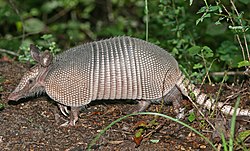
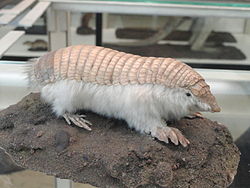



The armadillos are small mammals with a bony armored shell. All 21 extant species are found in South America, where they originated. Their much larger relatives, the pampatheres and glyptodonts, once lived in North and South America but became extinct following the appearance of humans.
- Family: Dasypodidae (long-nosed armadillos)
- Subfamily: Dasypodinae
- Genus: Dasypus
- Southern long-nosed armadillo, Dasypus hybridusNT
- Greater long-nosed armadillo, Dasypus kappleri LC
- Nine-banded armadillo, Dasypus novemcinctus LC
- Hairy long-nosed armadillo, Dasypus pilosusVU
- Llanos long-nosed armadillo, Dasypus sabanicola LC
- Seven-banded armadillo, Dasypus septemcinctus LC
- Yepes's mulita, Dasypus yepesiDD
- Genus: Dasypus
- Subfamily: Dasypodinae
- Family: Chlamyphoridae (armadillos)
- Subfamily Chlamyphorinae
- Genus: Calyptophractus
- Greater fairy armadillo, Calyptophractus retususDD
- Genus: Chlamyphorus
- Pink fairy armadillo, Chlamyphorus truncatusDD
- Genus: Calyptophractus
- Subfamily: Euphractinae
- Genus: Chaetophractus
- Andean hairy armadillo, Chaetophractus nationiVU
- Screaming hairy armadillo, Chaetophractus vellerosus LC
- Big hairy armadillo, Chaetophractus villosus LC
- Genus: Euphractus
- Six-banded armadillo, Euphractus sexcinctus LC
- Genus: Zaedyus
- Pichi, Zaedyus pichiyNT
- Genus: Chaetophractus
- Subfamily: Tolypeutinae
- Genus: Cabassous
- Northern naked-tailed armadillo, Cabassous centralisDD
- Chacoan naked-tailed armadillo, Cabassous chacoensisNT
- Greater naked-tailed armadillo, Cabassous tatouay LC
- Southern naked-tailed armadillo, Cabassous unicinctus LC
- Genus: Priodontes
- Giant armadillo, Priodontes maximusVU
- Genus: Tolypeutes
- Southern three-banded armadillo, Tolypeutes matacusNT
- Brazilian three-banded armadillo, Tolypeutes tricinctusVU
- Genus: Cabassous
- Subfamily Chlamyphorinae





Order: Pilosa (sloths and anteaters)
The order Pilosa is confined to the Americas and contains the tree sloths and anteaters (which include the tamanduas). All 5 extant genera and 9 of 10 extant species are present in South America, the ancestral home of the group. (The exception is the pygmy three-toed sloth, endemic to an island off Panama.) Numerous ground sloths, some of which reached the size of elephants, were once present in both North and South America, as well as on the Antilles. (Some west coastal South American forms had even evolved into marine sloths.) All of these went extinct following the arrival of humans. Extant tree sloths fall into two groups that are not closely related, and which do not form a clade; two-toed sloths are much more closely related to some extinct ground sloths than to three-toed sloths.
- Suborder: Folivora
- Family: Bradypodidae (three-toed sloths)
- Genus: Bradypus
- Maned sloth, Bradypus torquatusVU
- Pale-throated sloth, Bradypus tridactylus LC
- Brown-throated sloth, Bradypus variegatus LC
- Genus: Bradypus
- Family: Choloepodidae (two-toed sloths)
- Genus: Choloepus
- Linnaeus's two-toed sloth, Choloepus didactylus LC
- Hoffmann's two-toed sloth, Choloepus hoffmanni LC
- Genus: Choloepus
- Family: Bradypodidae (three-toed sloths)
- Suborder: Vermilingua
- Family: Cyclopedidae
- Genus: Cyclopes (silky anteaters)
- Family: Myrmecophagidae (American anteaters)
- Genus: Myrmecophaga
- Giant anteater, Myrmecophaga tridactylaVU
- Genus: Tamandua
- Northern tamandua, Tamandua mexicana LC
- Southern tamandua, Tamandua tetradactyla LC
- Genus: Myrmecophaga
- Family: Cyclopedidae
Superorder: Euarchontoglires
Order: Primates

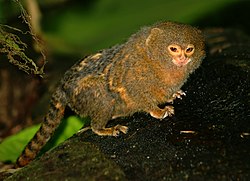









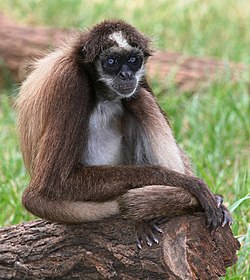

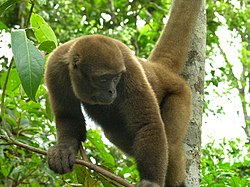








The order Primates includes the lemurs, monkeys, and apes, with the latter category including humans. It is divided into four main groupings: strepsirrhines, tarsiers, monkeys of the New World (parvorder Platyrrhini), and monkeys and apes of the Old World. South America's 20 genera of nonhuman primates compares with 6 in Central America, 15 in Madagascar, 23 in Africa and 19 in Asia. All South American monkeys are believed to be descended from ancestors that rafted over from Africa about 25 million years ago in a single dispersal event.
- Suborder: Haplorrhini
- Infraorder: Simiiformes
- Parvorder: Platyrrhini (New World monkeys)
- Family: Aotidae (night monkeys)
- Genus: Aotus
- Azara's night monkey, Aotus azarae LC
- Brumback's night monkey, Aotus brumbackiVU
- Gray-handed night monkey, Aotus griseimembraVU
- Hernández-Camacho's night monkey, Aotus jorgehernandeziDD
- Gray-bellied night monkey, Aotus lemurinusVU
- Peruvian night monkey, Aotus miconaxVU
- Nancy Ma's night monkey, Aotus nancymaae LC
- Black-headed night monkey, Aotus nigriceps LC
- Three-striped night monkey, Aotus trivirgatus LC
- Spix's night monkey, Aotus vociferans LC
- Panamanian night monkey, Aotus zonalisDD
- Genus: Aotus
- Family: Callitrichidae
- Genus: Callibella
- Roosmalens' dwarf marmoset, Callibella humilisVU
- Genus: Cebuella
- Pygmy marmoset, Cebuella pygmaea LC
- Genus: Callithrix
- Buffy-tufted marmoset, Callithrix auritaVU
- Buffy-headed marmoset, Callithrix flavicepsEN
- White-headed marmoset, Callithrix geoffroyi LC
- Common marmoset, Callithrix jacchus LC
- Wied's marmoset, Callithrix kuhliiNT
- Black-tufted marmoset, Callithrix penicillata LC
- Genus: Mico
- Rio Acari marmoset, Mico acariensisDD
- Silvery marmoset, Mico argentatus LC
- Gold-and-white marmoset, Mico chrysoleucusDD
- Emilia's marmoset, Mico emiliaeDD
- Santarem marmoset, Mico humeraliferDD
- Hershkovitz's marmoset, Mico intermedius LC
- White marmoset, Mico leucippeVU
- Manicore marmoset, Mico manicorensis LC
- Marca's marmoset, Mico marcaiDD
- Maués marmoset, Mico mauesi LC
- Black-tailed marmoset, Mico melanurus LC
- Black-headed marmoset, Mico nigricepsDD
- Rondon's marmoset, Mico rondoniVU
- Satéré marmoset, Mico saterei LC
- Genus: Callimico
- Goeldi's marmoset, Callimico goeldiiVU
- Genus: Leontopithecus
- Superagui lion tamarin, Leontopithecus caissaraCR
- Golden-headed lion tamarin, Leontopithecus chrysomelasEN
- Black lion tamarin, Leontopithecus chrysopygusEN
- Golden lion tamarin, Leontopithecus rosaliaEN
- Genus: Saguinus
- Pied tamarin, Saguinus bicolorEN
- Brown-mantled tamarin, Saguinus fuscicollis LC
- Geoffroy's tamarin, Saguinus geoffroyi LC
- Graells's tamarin, Saguinus graellsiNT
- Emperor tamarin, Saguinus imperator LC
- Mottle-faced tamarin, Saguinus inustus LC
- White-lipped tamarin, Saguinus labiatus LC
- White-footed tamarin, Saguinus leucopusEN
- Martins's tamarin, Saguinus martinsi LC
- White-mantled tamarin, Saguinus melanoleucus LC
- Red-handed tamarin, Saguinus midas LC
- Moustached tamarin, Saguinus mystax LC
- Black tamarin, Saguinus nigerVU
- Black-mantled tamarin, Saguinus nigricollis LC
- Cottontop tamarin, Saguinus oedipusCR
- Red-capped tamarin, Saguinus pileatus LC
- Golden-mantled tamarin, Saguinus tripartitusNT
- Genus: Callibella
- Family: Cebidae
- Subfamily: Cebinae
- Genus: Cebus
- Ecuadorian capuchin, Cebus aequatorialisCR
- White-fronted capuchin, Cebus albifrons LC
- Brown weeper capuchin, Cebus brunneus LC
- Colombian white-headed capuchin, Cebus capucinus LC
- Río Cesar white-fronted capuchin, Cebus cesaraeDD
- Shock-headed capuchin, Cebus cuscinusNT
- Kaapori capuchin, Cebus kaaporiCR
- Sierra de Perijá white-fronted capuchin, Cebus leucocephalusNE
- Santa Marta white-fronted capuchin, Cebus malitiosusEN
- Wedge-capped capuchin, Cebus olivaceus LC
- Spix's white-fronted capuchin, Cebus unicolorNE
- Varied white-fronted capuchin, Cebus versicolorEN
- Marañón white-fronted capuchin, Cebus yuracusNE
- Genus: Sapajus
- Tufted capuchin, Sapajus apella LC
- Azaras's capuchin, Sapajus cay LC
- Blond capuchin, Sapajus flaviusCR
- Black-striped capuchin, Sapajus libidinosus LC
- Large-headed capuchin, Sapajus macrocephalus LC
- Black capuchin, Sapajus nigritusNT
- Crested capuchin, Sapajus robustusEN
- Golden-bellied capuchin, Sapajus xanthosternosCR
- Genus: Cebus
- Subfamily: Saimiriinae
- Genus: Saimiri
- Black-capped squirrel monkey, Saimiri boliviensis LC
- Humboldt's squirrel monkey, Saimiri cassiquiarensis
- Collins' squirrel monkey, Saimiri collinsii
- Guianan squirrel monkey, Saimiri sciureus LC
- Bare-eared squirrel monkey, Saimiri ustusNT
- Black squirrel monkey, Saimiri vanzoliniiVU
- Genus: Saimiri
- Subfamily: Cebinae
- Family: Atelidae
- Subfamily: Alouattinae
- Genus: Alouatta
- Ursine howler, Alouatta arctoidea LC
- Red-handed howler, Alouatta belzebulVU
- Black howler, Alouatta caraya LC
- Spix's red-handed howler, Alouatta discolorVU
- Brown howler, Alouatta guariba LC
- Juruá red howler, Alouatta juara LC
- Guyanan red howler, Alouatta macconnelli LC
- Amazon black howler, Alouatta nigerrima LC
- Mantled howler, Alouatta palliata LC
- Purus red howler, Alouatta puruensis LC
- Bolivian red howler, Alouatta sara LC
- Venezuelan red howler, Alouatta seniculus LC
- Maranhão red-handed howler, Alouatta ululataEN
- Genus: Alouatta
- Subfamily: Atelinae
- Genus: Ateles
- White-fronted spider monkey, Ateles belzebuthEN
- Peruvian spider monkey, Ateles chamekEN
- Black-headed spider monkey, Ateles fuscicepsCR
- Geoffroy's spider monkey, Ateles geoffroyiEN
- Brown spider monkey, Ateles hybridusCR
- White-cheeked spider monkey, Ateles marginatusEN
- Red-faced spider monkey, Ateles paniscusVU
- Genus: Brachyteles
- Southern muriqui, Brachyteles arachnoidesEN
- Northern muriqui, Brachyteles hypoxanthusCR
- Genus: Lagothrix
- Gray woolly monkey, Lagothrix canaEN
- Brown woolly monkey, Lagothrix lagothrichaVU
- Colombian woolly monkey, Lagothrix lugensCR
- Silvery woolly monkey, Lagothrix poeppigiiVU
- Genus: Oreonax
- Yellow-tailed woolly monkey, Oreonax flavicaudaCR
- Genus: Ateles
- Subfamily: Alouattinae
- Family: Pitheciidae
- Subfamily: Callicebinae
- Genus: Cheracebus
- Lucifer titi, Cheracebus lucifer LC
- Black titi, Cheracebus lugens LC
- Colombian black-handed titi, Cheracebus medemiVU
- Rio Purus titi, Cheracebus purinus LC
- Red-headed titi, Cheracebus regulus LC
- Collared titi, Cheracebus torquatus LC
- Genus: Callicebus
- Barbara Brown's titi, Plecturocebus barbarabrownaeCR
- Coimbra Filho's titi, Callicebus coimbraiEN
- Coastal black-handed titi, Callicebus melanochirVU
- Black-fronted titi, Callicebus nigrifronsNT
- Atlantic titi, Callicebus personatusVU
- Genus: Plecturocebus
- Madidi titi, Plecturocebus aureipalatii LC
- Baptista Lake titi, Plecturocebus baptista LC
- Prince Bernhard's titi, Plecturocebus bernhardi LC
- Brown titi, Plecturocebus brunneus LC
- Chestnut-bellied titi, Plecturocebus caligatus LC
- Caquetá titi, Plecturocebus caquetensisCR
- Ashy black titi, Plecturocebus cinerascens LC
- Coppery titi, Plecturocebus cupreus LC
- White-tailed titi, Plecturocebus discolor LC
- White-eared titi, Plecturocebus donacophilus LC
- Hershkovitz's titi, Plecturocebus dubius LC
- Alta Floresta titi, Plecturocebus groves
- Hoffmanns's titi, Plecturocebus hoffmannsi LC
- Milton's titi, Plecturocebus miltoniNE
- Rio Beni titi, Plecturocebus modestusEN
- Red-bellied titi, Plecturocebus moloch LC
- Rio Mayo titi, Plecturocebus oenantheEN
- Ollala brothers' titi, Plecturocebus olallaeEN
- Ornate titi, Plecturocebus ornatusVU
- White-coated titi, Plecturocebus pallescens LC
- Stephen Nash's titi, Plecturocebus stephennashiDD
- Urubamba brown titi, Plecturocebus urubambensis NE
- Vieira's titi, Plecturocebus vieiraiNE
- Genus: Cheracebus
- Subfamily: Pitheciinae
- Genus: Pithecia
- Equatorial saki, Pithecia aequatorialis LC
- White-footed saki, Pithecia albicansVU
- Cazuza's saki, Pithecia cazuzai NE
- Golden-faced saki, Pithecia chrysocephala LC
- Hairy saki, Pithecia hirsuta NE
- Burnished saki, Pithecia inusta NE
- Rio Tapajós saki, Pithecia irrorataNE
- Isabel's saki, Pithecia isabela NE
- Monk saki, Pithecia monachusNE
- Miller's saki, Pithecia milleriDD
- Mittermeier's Tapajós saki, Pithecia mittermeieri NE
- Napo saki, Pithecia napensisDD
- White-faced saki, Pithecia pithecia LC
- Pissinatti's bald-faced saki, Pithecia pissinattii NE
- Rylands' bald-faced saki, Pithecia rylandsi NE
- Vanzolini's bald-faced saki, Pithecia vanzoliniiDD
- Genus: Chiropotes
- White-nosed saki, Chiropotes albinasusEN
- Red-backed bearded saki, Chiropotes chiropotes LC
- Brown-backed bearded saki, Chiropotes israelita
- Black bearded saki, Chiropotes satanasCR
- Uta Hick's bearded saki, Chiropotes utahickiEN
- Genus: Cacajao
- Aracá uakari, Cacajao ayresiiVU
- Bald uakari, Cacajao calvusVU
- Neblina uakari, Cacajao hosomiVU
- Golden-backed uakari, Cacajao melanocephalus LC
- Genus: Pithecia
- Subfamily: Callicebinae
- Family: Aotidae (night monkeys)
- Parvorder: Platyrrhini (New World monkeys)
- Infraorder: Simiiformes
Order: Rodentia (rodents)
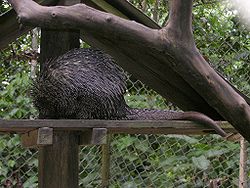







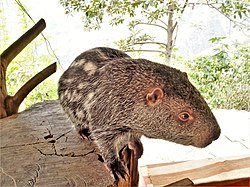


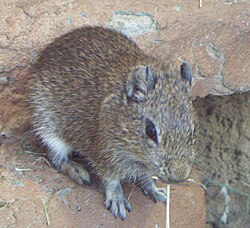












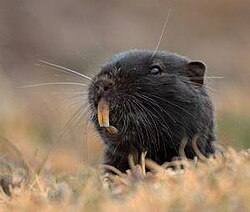





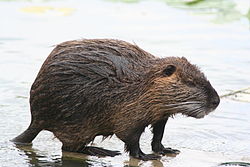
Rodents make up the largest order of mammals, with over 40% of mammalian species. They have two incisors in the upper and lower jaw which grow continually and must be kept short by gnawing. Most rodents are small, although the capybara can weigh up to 45 kg (100 lb). South America's rodent fauna today is largely an outgrowth of two spectacularly fortunate ancient "sweepstakes" dispersal events, each of which was followed by explosive diversification. Caviomorphs, the first rodents to reach the continent, are believed to have washed ashore after rafting across the Atlantic from Africa over 30 million years ago. [8] More recently, ancestral sigmodontine rodents [9] apparently island-hopped from Central America 5 million or more years ago, [10] [11] [12] prior to the formation of the Panamanian land bridge. These two groups now comprise 36% and 60%, respectively, of all South American rodent species. The corresponding figures are 10% and 27% for Central America, 2% and 10% for Mexico, 0.5% and 3% for North America north of Mexico, and 72% and 27% for recent endemic Caribbean rodents. [n 2] Conversely, sciurids make up 3% of rodents in South America, 8% in Central America, 15% in Mexico and 31% in North America north of Mexico, while castorimorphs are 1%, 16%, 26% and 28%, respectively. Sciurids are absent from South America's southern cone, while castorimorphs are only present in northwest South America (Colombia, Venezuela and Ecuador). Illustrating the advantage of gaining a head start in colonizing a new land mass, sigmodontine rodents comprise 99.5% of all cricetid rodents in South America, but only 42% in Central America, 17% in Mexico and 7% in North America north of Mexico.
- Suborder: Hystricomorpha
- Parvorder Caviomorpha
- Family: Erethizontidae (New World porcupines)
- Subfamily: Chaetomyinae
- Genus: Chaetomys
- Bristle-spined rat, Chaetomys subspinosusVU
- Genus: Chaetomys
- Subfamily: Erethizontinae
- Genus: Coendou
- Baturite porcupine, Coendou baturitensis
- Bicolored-spined porcupine, Coendou bicolor LC
- Streaked dwarf porcupine, Coendou ichillusDD
- Bahia porcupine, Coendou insidiosus LC
- Black-tailed hairy dwarf porcupine, Coendou melanurus LC
- Black dwarf porcupine, Coendou nycthemeraDD
- Brazilian porcupine, Coendou prehensilis LC
- Frosted hairy dwarf porcupine, Coendou pruinosus LC
- Andean porcupine, Coendou quichuaDD
- Roosmalen's dwarf porcupine, Coendou roosmalenorumDD
- Rothschild's porcupine, Coendou rothschildiDD
- Stump-tailed porcupine, Coendou rufescens LC
- Santa Marta porcupine, Coendou sanctamartaeDD
- Dwarf porcupine, Coendou speratus EN
- Paraguaian hairy dwarf porcupine, Coendou spinosus LC
- Brown hairy dwarf porcupine, Coendou vestitusDD
- Genus: Coendou
- Subfamily: Chaetomyinae
- Family: Chinchillidae (viscachas and chinchillas)
- Genus: Chinchilla
- Short-tailed chinchilla, Chinchilla chinchillaCR
- Long-tailed chinchilla, Chinchilla lanigeraCR
- Genus: Lagidium
- Lagidium ahuacaense
- Northern viscacha, Lagidium peruanum LC
- Southern viscacha, Lagidium viscacia LC
- Wolffsohn's viscacha, Lagidium wolffsohniDD
- Genus: Lagostomus
- Plains viscacha, Lagostomus maximus LC
- Genus: Chinchilla
- Family: Dinomyidae (pacarana)
- Family: Caviidae (guinea pigs and cavies)
- Subfamily: Caviinae
- Genus: Cavia
- Brazilian guinea pig, Cavia aperea LC
- Shiny guinea pig, Cavia fulgida LC
- Santa Catarina's guinea pig, Cavia intermediaCR
- Greater guinea pig, Cavia magna LC
- Montane guinea pig, Cavia tschudii LC
- Genus: Galea
- Southern highland yellow-toothed cavy, Galea comes DD
- Brazilian yellow-toothed cavy, Galea flavidens LC
- Lowland yellow-toothed cavy, Galea leucoblephara LC
- Common yellow-toothed cavy, Galea musteloides LC
- Muenster yellow-toothed cavy, Galea m. monasteriensisNE
- Spix's yellow-toothed cavy, Galea spixii LC
- Genus: Microcavia
- Southern mountain cavy, Microcavia australis LC
- Andean mountain cavy, Microcavia niata LC
- Shipton's mountain cavy, Microcavia shiptoniNT
- Genus: Cavia
- Subfamily: Dolichotinae
- Genus: Dolichotis
- Patagonian mara, Dolichotis patagonumNT
- Chacoan mara, Dolichotis salinicola LC
- Genus: Dolichotis
- Subfamily: Hydrochoerinae (capybaras and rock cavies)
- Genus: Hydrochoerus
- Capybara, Hydrochoerus hydrochaeris LC
- Lesser capybara, Hydrochoerus isthmiusDD
- Genus: Kerodon
- Acrobatic cavy, Kerodon acrobataDD
- Rock cavy, Kerodon rupestris LC
- Genus: Hydrochoerus
- Subfamily: Caviinae
- Family: Dasyproctidae (agoutis and acouchis)
- Genus: Dasyprocta
- Azara's agouti, Dasyprocta azaraeDD
- Crested agouti, Dasyprocta cristataDD
- Black agouti, Dasyprocta fuliginosa LC
- Orinoco agouti, Dasyprocta guamaraNT
- Kalinowski's agouti, Dasyprocta kalinowskiiDD
- Red-rumped agouti, Dasyprocta leporina LC
- Black-rumped agouti, Dasyprocta prymnolopha LC
- Central American agouti, Dasyprocta punctata LC
- Genus: Myoprocta
- Red acouchi, Myoprocta acouchy LC
- Green acouchi, Myoprocta pratti LC
- Genus: Dasyprocta
- Family: Cuniculidae
- Genus: Cuniculus
- Cuniculus hernandezi
- Lowland paca, Cuniculus paca LC
- Mountain paca, Cuniculus taczanowskiiNT
- Genus: Cuniculus
- Family: Ctenomyidae (tuco-tucos)
- Genus: Ctenomys
- Argentine tuco-tuco, Ctenomys argentinusNT
- Southern tuco-tuco, Ctenomys australisEN
- Azara's tuco-tuco, Ctenomys azaraeVU
- Berg's tuco-tuco, Ctenomys bergiVU
- Bolivian tuco-tuco, Ctenomys boliviensis LC
- Bonetto's tuco-tuco, Ctenomys bonettoiEN
- Brazilian tuco-tuco, Ctenomys brasiliensisDD
- Budin's tuco-tuco, Ctenomys budiniDD
- Colburn's tuco-tuco, Ctenomys colburniDD
- Puntilla tuco-tuco, Ctenomys coludoDD
- Conover's tuco-tuco, Ctenomys conoveri LC
- Coyhaique tuco-tuco, Ctenomys coyhaiquensisDD
- D'Orbigny's tuco-tuco, Ctenomys dorbignyiNT
- Chacoan tuco-tuco, Ctenomys dorsalisDD
- Emily's tuco-tuco, Ctenomys emilianusNT
- Famatina tuco-tuco, Ctenomys famosusDD
- Flamarion's tuco-tuco, Ctenomys flamarioniEN
- Foch's tuco-tuco, Ctenomys fochiDD
- Lago Blanco tuco-tuco, Ctenomys fodaxDD
- Reddish tuco-tuco, Ctenomys frater LC
- Tawny tuco-tuco, Ctenomys fulvus LC
- Goodfellow's tuco-tuco, Ctenomys goodfellowi LC
- Haig's tuco-tuco, Ctenomys haigi LC
- San Juan tuco-tuco, Ctenomys johannisDD
- Jujuy tuco-tuco, Ctenomys jurisDD
- Catamarca tuco-tuco, Ctenomys knightiDD
- Lami tuco-tuco, Ctenomys lamiVU
- Mottled tuco-tuco, Ctenomys latroVU
- White-toothed tuco-tuco, Ctenomys leucodon LC
- Lewis's tuco-tuco, Ctenomys lewisi LC
- Magellanic tuco-tuco, Ctenomys magellanicusVU
- Maule tuco-tuco, Ctenomys maulinus LC
- Mendoza tuco-tuco, Ctenomys mendocinus LC
- Tiny tuco-tuco, Ctenomys minutusDD
- Furtive tuco-tuco, Ctenomys occultusEN
- Highland tuco-tuco, Ctenomys opimus LC
- Reig's tuco-tuco, Ctenomys osvaldoreigiCR
- Ctenomys paraguayensis
- Pearson's tuco-tuco, Ctenomys pearsoniNT
- Goya tuco-tuco, Ctenomys perrensi LC
- Peruvian tuco-tuco, Ctenomys peruanus LC
- Pilar tuco-tuco, Ctenomys pilarensisEN
- San Luis tuco-tuco, Ctenomys pontifexDD
- Porteous's tuco-tuco, Ctenomys porteousiNT
- Pundt's tuco-tuco, Ctenomys pundtiVU
- Rio Negro tuco-tuco, Ctenomys rionegrensisEN
- Roig's tuco-tuco, Ctenomys roigiCR
- Salta tuco-tuco, Ctenomys saltariusDD
- Scaglia's tuco-tuco, Ctenomys scagliaiDD
- Silky tuco-tuco, Ctenomys sericeusDD
- Social tuco-tuco, Ctenomys sociabilisCR
- Steinbach's tuco-tuco, Ctenomys steinbachi LC
- Forest tuco-tuco, Ctenomys sylvanusDD
- Talas tuco-tuco, Ctenomys talarum LC
- Collared tuco-tuco, Ctenomys torquatus LC
- Robust tuco-tuco, Ctenomys tuconaxDD
- Tucuman tuco-tuco, Ctenomys tucumanusDD
- Sierra Tontal tuco-tuco, Ctenomys tulducoDD
- Strong tuco-tuco, Ctenomys validusDD
- Vipos tuco-tuco, Ctenomys viperinusDD
- Yolanda's tuco-tuco, Ctenomys yolandaeDD
- Genus: Ctenomys
- Family: Octodontidae
- Genus: Aconaemys
- Chilean rock rat, Aconaemys fuscus LC
- Porter's rock rat, Aconaemys porteriDD
- Sage's rock rat, Aconaemys sageiDD
- Genus: Octodon
- Bridges's degu, Octodon bridgesiVU
- Common degu, Octodon degus LC
- Moon-toothed degu, Octodon lunatusVU
- Pacific degu, Octodon pacificusCR
- Genus: Octodontomys
- Mountain degu, Octodontomys gliroides LC
- Genus: Octomys
- Mountain viscacha rat, Octomys mimax LC
- Genus: Pipanacoctomys
- Golden viscacha rat, Pipanacoctomys aureusCR
- Genus: Spalacopus
- Coruro, Spalacopus cyanus LC
- Genus: Tympanoctomys
- Plains viscacha rat, Tympanoctomys barreraeNT
- Kirchner's viscacha rat, Tympanoctomys kirchnerorumDD
- Chalchalero viscacha rat, Tympanoctomys loschalchalerosorumCR
- Genus: Aconaemys
- Family: Abrocomidae
- Genus: Abrocoma
- Bennett's chinchilla rat, Abrocoma bennettii LC
- Bolivian chinchilla rat, Abrocoma boliviensisCR
- Budin's chinchilla rat, Abrocoma budiniDD
- Ashy chinchilla rat, Abrocoma cinerea LC
- Famatina chinchilla rat, Abrocoma famatinaDD
- Sierra del Tontal chinchilla rat, Abrocoma schistaceaDD
- Uspallata chinchilla rat, Abrocoma uspallataDD
- Punta de Vacas chinchilla rat, Abrocoma vaccarumDD
- Genus: Abrocoma
- Family: Echimyidae (spiny rats and allies)
- Subfamily: Dactylomyinae
- Genus: Kannabateomys
- Atlantic bamboo rat, Kannabateomys amblyonyx LC
- Genus: Dactylomys
- Bolivian bamboo rat, Dactylomys boliviensis LC
- Amazon bamboo rat, Dactylomys dactylinus LC
- Montane bamboo rat, Dactylomys peruanusDD
- Genus: Olallamys
- White-tailed olalla rat, Olallamys albicaudaDD
- Greedy olalla rat, Olallamys edaxDD
- Genus: Kannabateomys
- Subfamily: Echimyinae
- Genus: Callistomys
- Painted tree-rat, Callistomys pictusEN
- Genus: Diplomys
- Colombian soft-furred spiny rat, Diplomys canicepsDD
- Rufous soft-furred spiny rat, Diplomys labilis LC
- Genus: Echimys
- White-faced spiny tree-rat, Echimys chrysurus LC
- Dark spiny tree-rat, Echimys saturnusDD
- Echimys vieirai DD
- Genus: Isothrix
- Isothrix barbarabrownae DD
- Yellow-crowned brush-tailed rat, Isothrix bistriata LC
- Rio Negro brush-tailed rat, Isothrix negrensis LC
- Plain brush-tailed rat, Isothrix pagurus LC
- Sinnamary brush-tailed rat, Isothrix sinnamariensis LC
- Genus: Makalata
- Makalata castaneus
- Brazilian spiny tree-rat, Makalata didelphoides LC
- Makalata handleyi
- Makalata guianae
- Makalata longirostris
- Long-tailed armored tree-rat, Makalata macrura LC
- Dusky spiny tree-rat, Makalata obscuraDD
- Peruvian tree-rat, Makalata rhipiduraDD
- Genus: Pattonomys
- Bare-tailed armored tree-rat, Pattonomys occasiusDD
- Speckled spiny tree-rat, Pattonomys semivillosus LC
- Genus: Phyllomys
- Golden Atlantic tree-rat, Phyllomys blainvilii LC
- Orange-brown Atlantic tree-rat, Phyllomys brasiliensisEN
- Drab Atlantic tree-rat, Phyllomys dasythrix LC
- Kerr's Atlantic tree-rat, Phyllomys kerriDD
- Pallid Atlantic tree-rat, Phyllomys lamarumDD
- Lund's Atlantic tree-rat, Phyllomys lundiEN
- Mantiqueira Atlantic tree-rat, Phyllomys mantiqueirensisCR
- Long-furred Atlantic tree-rat, Phyllomys medius LC
- Black-spined Atlantic tree-rat, Phyllomys nigrispinus LC
- Rusty-sided Atlantic tree-rat, Phyllomys pattoni LC
- Phyllomys sulinus
- Giant Atlantic tree-rat, Phyllomys thomasiEN
- Short-furred Atlantic tree-rat, Phyllomys unicolorCR
- Genus: Santamartamys
- Red-crested tree-rat, Santamartamys rufodorsalisCR
- Genus: Toromys
- Giant tree-rat, Toromys grandis LC
- Genus: Callistomys
- Subfamily: Eumysopinae
- Genus: Carterodon
- Owl's spiny rat, Carterodon sulcidensDD
- Genus: Clyomys
- Broad-headed spiny rat, Clyomys laticeps LC
- Genus: Euryzygomatomys
- Brandt's guiara, Euryzygomatomys guiara
- Fischer's guiara, Euryzygomatomys spinosus LC
- Genus: Hoplomys
- Armored rat, Hoplomys gymnurus LC
- Genus: Lonchothrix
- Tuft-tailed spiny tree rat, Lonchothrix emiliae LC
- Genus: Mesomys
- Ferreira's spiny tree-rat, Mesomys hispidus LC
- Woolly-headed spiny tree-rat, Mesomys lenicepsDD
- Tufted-tailed spiny tree-rat, Mesomys occultus LC
- Pará spiny tree-rat, Mesomys stimulax LC
- Genus: Proechimys
- Short-tailed spiny rat, Proechimys brevicauda LC
- Colombian spiny rat, Proechimys canicollis LC
- Boyacá spiny rat, Proechimys chrysaeolusDD
- Cuvier's spiny rat, Proechimys cuvieri LC
- Pacific spiny rat, Proechimys decumanusVU
- Stiff-spine spiny rat, Proechimys echinothrix LC
- Gardner's spiny rat, Proechimys gardneriDD
- Goeldi's spiny rat, Proechimys goeldiiVU
- Guaira spiny rat, Proechimys guairae LC
- Guyenne spiny rat, Proechimys guyannensis LC
- Guyanan spiny rat, Proechimys hoplomyoidesDD
- Kulina spiny rat, Proechimys kulinaeDD
- Long-tailed spiny rat, Proechimys longicaudatus LC
- Magdalena spiny rat, Proechimys magdalenaeDD
- Minca spiny rat, Proechimys mincaeDD
- O'Connell's spiny rat, Proechimys oconnelliDD
- Patton's spiny rat, Proechimys pattoni LC
- Gray-footed spiny rat, Proechimys poliopusVU
- Napo spiny rat, Proechimys quadruplicatus LC
- Roberto's spiny rat, Proechimys robertiVU
- Tome's spiny rat, Proechimys semispinosus LC
- Simon's spiny rat, Proechimys simonsi LC
- Steere's spiny rat, Proechimys steerei LC
- Trinidad spiny rat, Proechimys trinitatisDD
- Sucre spiny rat, Proechimys urichi LC
- Genus: Thrichomys
- Common punaré, Thrichomys apereoides LC
- Thrichomys fosteri NE
- Highlands punaré, Thrichomys inermis LC
- Sao Lourenço punaré, Thrichomys laurentiusDD
- Paraguayan punaré, Thrichomys pachyurus LC
- Genus: Trinomys
- White-spined Atlantic spiny rat, Trinomys albispinus LC
- Soft-spined Atlantic spiny rat, Trinomys dimidiatus LC
- Elias' Atlantic spiny rat, Trinomys eliasiEN
- Gracile Atlantic spiny rat, Trinomys gratiosus LC
- Ihering's Atlantic spiny rat, Trinomys iheringi LC
- Dark-caped Atlantic spiny rat, Trinomys mirapitangaDD
- Moojen's Atlantic spiny rat, Trinomys moojeniEN
- Mouse-tailed Atlantic spiny rat, Trinomys myosuros LC
- Spiked Atlantic spiny rat, Trinomys paratusDD
- Hairy Atlantic spiny rat, Trinomys setosus LC
- Yonenaga's Atlantic spiny rat, Trinomys yonenagaeEN
- Genus: Carterodon
- Subfamily: Dactylomyinae
- Family: Myocastoridae (coypus)
- Family: Erethizontidae (New World porcupines)
- Parvorder Caviomorpha


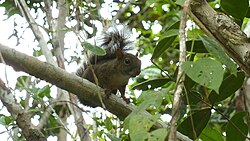

- Suborder: Sciuromorpha
- Family: Sciuridae (squirrels)
- Subfamily: Sciurillinae
- Genus: Sciurillus
- Neotropical pygmy squirrel, Sciurillus pusillusDD
- Genus: Sciurillus
- Subfamily: Sciurinae
- Tribe: Sciurini
- Genus: Microsciurus
- Central American dwarf squirrel, Microsciurus alfari LC
- Amazon dwarf squirrel, Microsciurus flaviventerDD
- Western dwarf squirrel, Microsciurus mimulus LC
- Santander dwarf squirrel, Microsciurus santanderensisDD
- Genus: Sciurus
- Brazilian squirrel, Sciurus aestuans LC
- South Yungas red squirrel, Sciurus argentinius
- Fiery squirrel, Sciurus flammiferDD
- Yellow-throated squirrel, Sciurus gilvigularisDD
- Red-tailed squirrel, Sciurus granatensis LC
- Bolivian squirrel, Sciurus ignitusDD
- Northern Amazon red squirrel, Sciurus igniventris LC
- Atlantic Forest squirrel, Sciurus ingrami
- Andean squirrel, Sciurus pucheraniiDD
- Junín red squirrel, Sciurus pyrrhinusDD
- Sanborn's squirrel, Sciurus sanborniDD
- Southern Amazon red squirrel, Sciurus spadiceus LC
- Guayaquil squirrel, Sciurus stramineus LC
- Genus: Microsciurus
- Tribe: Sciurini
- Subfamily: Sciurillinae
- Family: Sciuridae (squirrels)
- Suborder: Castorimorpha
- Family: Geomyidae
- Genus: Orthogeomys
- Thaeler's pocket gopher, Orthogeomys thaeleri LC
- Genus: Orthogeomys
- Family: Heteromyidae
- Subfamily: Heteromyinae
- Genus: Heteromys
- Trinidad spiny pocket mouse, Heteromys anomalus LC
- Southern spiny pocket mouse, Heteromys australis LC
- Overlook spiny pocket mouse, Heteromys catopterius NE
- Desmarest's spiny pocket mouse, Heteromys desmarestianus LC
- Paraguaná spiny pocket mouse, Heteromys oasicusEN
- Ecuadoran spiny pocket mouse, Heteromys teleusVU
- Genus: Heteromys
- Subfamily: Heteromyinae
- Family: Geomyidae
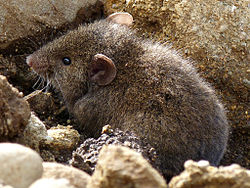
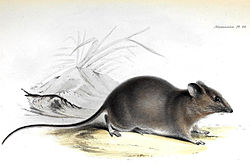







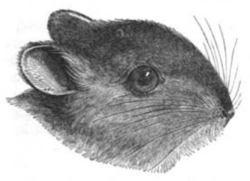


- Suborder: Myomorpha
- Family: Cricetidae
- Subfamily: Tylomyinae
- Genus: Tylomys
- Mira climbing rat, Tylomys mirae LC
- Genus: Tylomys
- Subfamily: Neotominae
- Genus: Reithrodontomys
- Mexican harvest mouse, Reithrodontomys mexicanus LC
- Genus: Reithrodontomys
- Subfamily: Sigmodontinae
- Genus: Abrawayaomys
- Abrawayaomys chebezi
- Ruschi's rat, Abrawayaomys ruschii LC
- Genus: Abrothrix
- Andean Altiplano mouse, Abrothrix andinus LC
- Hershkovitz's grass mouse, Abrothrix hershkovitzi LC
- Gray grass mouse, Abrothrix illuteusNT
- Jelski's Altiplano mouse, Abrothrix jelskii LC
- Woolly grass mouse, Abrothrix lanosus LC
- Long-haired grass mouse, Abrothrix longipilis LC
- Olive grass mouse, Abrothrix olivaceus LC
- Sanborn's grass mouse, Abrothrix sanborniNT
- Genus: Aepeomys
- Olive montane mouse, Aepeomys lugens LC
- Reig's montane mouse, Aepeomys reigiVU
- Genus: Aegialomys
- Galápagos rice rat, Aegialomys galapagoensisVU
- Yellowish rice rat, Aegialomys xanthaeolus LC
- Genus: Akodon
- Highland grass mouse, Akodon aerosus LC
- Colombian grass mouse, Akodon affinis LC
- White-bellied grass mouse, Akodon albiventer LC
- Azara's grass mouse, Akodon azarae LC
- Bogotá grass mouse, Akodon bogotensis LC
- Bolivian grass mouse, Akodon boliviensis LC
- Budin's grass mouse, Akodon budini LC
- Akodon caenosus
- Cursor grass mouse, Akodon cursor LC
- Day's grass mouse, Akodon dayi LC
- Dolorous grass mouse, Akodon dolores LC
- Smoky grass mouse, Akodon fumeus LC
- Akodon glaucinus
- Intelligent grass mouse, Akodon iniscatus LC
- Junín grass mouse, Akodon juninensis LC
- Koford's grass mouse, Akodon kofordi LC
- Ecuadorian grass mouse, Akodon latebricolaVU
- Lindbergh's grass mouse, Akodon lindberghiDD
- Altiplano grass mouse, Akodon lutescens LC
- Thespian grass mouse, Akodon mimus LC
- Soft grass mouse, Akodon mollis LC
- Montane grass mouse, Akodon montensis LC
- Caparaó grass mouse, Akodon mystaxDD
- Neuquén grass mouse, Akodon neocenusDD
- El Dorado grass mouse, Akodon orophilus LC
- Paraná grass mouse, Akodon paranaensis LC
- Tarija akodont, Akodon pervalensDD
- Philip Myers's akodont, Akodon philipmyersiDD
- Akodon polopi
- Reig's grass mouse, Akodon reigi LC
- São Paulo grass mouse, Akodon sanctipaulensisDD
- Serra do Mar grass mouse, Akodon serrensis LC
- Cochabamba grass mouse, Akodon siberiaeNT
- White-throated grass mouse, Akodon simulator LC
- Spegazzini's grass mouse, Akodon spegazzinii LC
- Puno grass mouse, Akodon subfuscus LC
- Silent grass mouse, Akodon surdusVU
- Forest grass mouse, Akodon sylvanus LC
- Akodon tartareus
- Chaco grass mouse, Akodon toba LC
- Cloud forest grass mouse, Akodon torques LC
- Variable grass mouse, Akodon variusDD
- Genus: Amphinectomys
- Ucayali water rat, Amphinectomys savamisDD
- Genus: Andalgalomys
- Olrog's chaco mouse, Andalgalomys olrogi LC
- Pearson's chaco mouse, Andalgalomys pearsoni LC
- Genus: Andinomys
- Andean mouse, Andinomys edax LC
- Andinomys lineicaudatus
- Genus: Anotomys
- Aquatic rat, Anotomys leanderVU
- Genus: Auliscomys
- Bolivian big-eared mouse, Auliscomys boliviensis LC
- Painted big-eared mouse, Auliscomys pictus LC
- Andean big-eared mouse, Auliscomys sublimis LC
- Genus: Bibimys
- Chaco crimson-nosed rat, Bibimys chacoensis LC
- Large-lipped crimson-nosed rat, Bibimys labiosus LC
- Torres' crimson-nosed rat, Bibimys torresiNT
- Genus: Blarinomys
- Brazilian shrew-mouse, Blarinomys breviceps LC
- Genus: Brucepattersonius
- Gray-bellied brucie, Brucepattersonius griserufescensDD
- Guaraní brucie, Brucepattersonius guaraniDD
- Red-bellied brucie, Brucepattersonius igniventrisDD
- Ihering's hocicudo, Brucepattersonius iheringi LC
- Misiones brucie, Brucepattersonius misionensisDD
- Arroyo of Paradise brucie, Brucepattersonius paradisusDD
- Soricine brucie, Brucepattersonius soricinusDD
- Genus: Calomys
- Bolivian vesper mouse, Calomys boliviae LC
- Crafty vesper mouse, Calomys callidus LC
- Large vesper mouse, Calomys callosus LC
- Calomys cerqueirai
- Caatinga vesper mouse, Calomys expulsus LC
- Fecund vesper mouse, Calomys fecundus LC
- Hummelinck's vesper mouse, Calomys hummelinckiVU
- Small vesper mouse, Calomys laucha LC
- Andean vesper mouse, Calomys lepidus LC
- Drylands vesper mouse, Calomys musculinus LC
- Peruvian vesper mouse, Calomys sorellus LC
- Delicate vesper mouse, Calomys tener LC
- Tocantins vesper mouse, Calomys tocantinsi LC
- Córdoba vesper mouse, Calomys venustus LC
- Genus: Cerradomys
- Langguth's rice rat, Cerradomys langguthi
- Maracaju rice rat, Cerradomys maracajuensis LC
- Marinho's rice rat, Cerradomys marinhusDD
- Lindbergh's rice rat, Cerradomys scotti LC
- Terraced rice rat, Cerradomys subflavus LC
- Vivo's rice rat, Cerradomys vivoi
- Genus: Chelemys
- Magellanic long-clawed mouse, Chelemys delfiniDD
- Andean long-clawed mouse, Chelemys macronyx LC
- Large long-clawed mouse, Chelemys megalonyxNT
- Genus: Chibchanomys
- Las Cajas water mouse, Chibchanomys orcesiDD
- Chibchan water mouse, Chibchanomys trichotisDD
- Genus: Chilomys
- Colombian forest mouse, Chilomys instans LC
- Genus: Chinchillula
- Altiplano chinchilla mouse, Chinchillula sahamae LC
- Genus: Delomys
- Delomys altimontanus
- Montane Atlantic Forest rat, Delomys collinus LC
- Striped Atlantic Forest rat, Delomys dorsalis LC
- Pallid Atlantic Forest rat, Delomys sublineatus LC
- Genus: Deltamys
- Kemp's grass mouse, Deltamys kempi LC
- Genus: Drymoreomys
- Genus: Eligmodontia
- Eligmodontia bolsonensis
- Eligmodontia hirtipes
- Monte gerbil mouse, Eligmodontia moreni LC
- Morgan's gerbil mouse, Eligmodontia morgani LC
- Andean gerbil mouse, Eligmodontia puerulus LC
- Highland gerbil mouse, eastern Patagonian gerbil mouse, Eligmodontia typus LC
- Genus: Eremoryzomys
- Gray rice rat, Eremoryzomys poliusDD
- Genus: Euneomys
- Patagonian chinchilla mouse, Euneomys chinchilloidesDD
- Burrowing chinchilla mouse, Euneomys fossor DD
- Biting chinchilla mouse, Euneomys mordax LC
- Peterson's chinchilla mouse, Euneomys petersoni LC
- Genus: Euryoryzomys
- Emmons's rice rat, Euryoryzomys emmonsaeDD
- Monster rice rat, Euryoryzomys lamiaEN
- Tarija rice rat, Euryoryzomys legatus LC
- MacConnell's rice rat, Euryoryzomys macconnelli LC
- Elegant rice rat, Euryoryzomys nitidus LC
- Russet rice rat, Euryoryzomys russatus LC
- Genus: Galenomys
- Garlepp's mouse, Galenomys garleppiDD
- Genus: Geoxus
- Long-clawed mole mouse, Geoxus valdivianus LC
- Genus: Graomys
- Graomys chacoensis (contains the former Graomys centralis )
- Pale leaf-eared mouse, Graomys domorum LC
- Edith's leaf-eared mouse, Graomys edithaeDD
- Gray leaf-eared mouse, Graomys griseoflavus LC
- Genus: Gyldenstolpia
- Fossorial giant rat, Gyldenstolpia frontoEN
- Gyldenstolpia planaltensis
- Genus: Handleyomys
- Alfaro's rice rat, Handleyomys alfaroi LC
- Dusky montane mouse, Handleyomys fuscatus LC
- Colombian rice rat, Handleyomys intectus LC
- Genus: Holochilus
- Web-footed marsh rat, Holochilus brasiliensis LC
- Chaco marsh rat, Holochilus chacarius LC
- Amazonian marsh rat, Holochilus sciureus LC
- Genus: Hylaeamys
- Hylaeamys acritus DD
- Large-headed rice rat, Hylaeamys laticepsNT
- Azara's broad-headed rice rat, Hylaeamys megacephalus LC
- Sowbug rice rat, Hylaeamys oniscusVU
- Western Amazonian oryzomys, Hylaeamys perenensis LC
- Tate's rice rat, Hylaeamys tateiDD
- Yungas rice rat, Hylaeamys yunganus LC
- Genus: Ichthyomys
- Crab-eating rat, Ichthyomys hydrobatesNT
- Pittier's crab-eating rat, Ichthyomys pittieriVU
- Stolzmann's crab-eating rat, Ichthyomys stolzmanniDD
- Tweedy's crab-eating rat, Ichthyomys tweediiDD
- Genus: Irenomys
- Chilean climbing mouse, Irenomys tarsalis LC
- Genus: Juliomys
- Juliomys ossitenuis NE
- Lesser Wilfred's mouse, Juliomys pictipes LC
- Cleft-headed juliomys, Juliomys rimofronsVU
- Aracuaria Forest tree mouse, Juliomys ximenezi NE
- Genus: Juscelinomys
- Rio Guaporé mouse, Juscelinomys guaporensisDD
- Huanchaca mouse, Juscelinomys huanchacaeDD
- Genus: Kunsia
- Woolly giant rat, Kunsia tomentosus LC
- Genus: Lenoxus
- Andean rat, Lenoxus apicalis LC
- Genus: Loxodontomys
- Southern big-eared mouse, Loxodontomys micropus LC
- Pikumche pericote, Loxodontomys pikumche LC
- Genus: Lundomys
- Lund's amphibious rat, Lundomys molitor LC
- Genus: Melanomys
- Dusky rice rat, Melanomys caliginosus LC
- Robust dark rice rat, Melanomys robustulus LC
- Zuniga's dark rice rat, Melanomys zunigaeCR
- Genus: Microakodontomys
- Intermediate lesser grass mouse, Microakodontomys transitoriusVU
- Genus: Microryzomys
- Highland small rice rat, Microryzomys altissimus LC
- Forest small rice rat, Microryzomys minutus LC
- Genus: Mindomys
- Hammond's rice rat, Mindomys hammondiEN
- Genus: Neacomys
- Dubost's bristly mouse, Neacomys dubosti LC
- Guiana bristly mouse, Neacomys guianae LC
- Jurua bristly mouse, Neacomys minutus LC
- Musser's bristly mouse, Neacomys musseri LC
- Paracou bristly mouse, Neacomys paracou LC
- Common bristly mouse, Neacomys spinosus LC
- Narrow-footed bristly mouse, Neacomys tenuipes LC
- Genus: Necromys
- Pleasant bolo mouse, Necromys amoenus LC
- Argentine bolo mouse, Necromys benefactus LC
- Rufous-bellied bolo mouse, Necromys lactens LC
- Hairy-tailed bolo mouse, Necromys lasiurus LC
- Paraguayan bolo mouse, Necromys lenguarum LC
- Dark bolo mouse, Necromys obscurusNT
- Spotted bolo mouse, Necromys punctulatusDD
- Temchuk's bolo mouse, Necromys temchuki LC
- Northern grass mouse, Necromys urichi LC
- Genus: Nectomys
- Western Amazonian water rat, Nectomys apicalis LC
- Magdalena water rat, Nectomys magdalenaeDD
- Trinidad water rat, Nectomys palmipes LC
- Small-footed bristly mouse, Nectomys rattus LC
- Scaly-footed water rat, Nectomys squamipes LC
- Genus: Neotomys
- Andean swamp rat, Neotomys ebriosus LC
- Genus: Nephelomys
- Tomes's rice rat, Nephelomys albigularis LC
- Nephelomys auriventer LC
- Costa Central rice rat, Nephelomys caracolus LC
- Nephelomys childi
- Keays's rice rat, Nephelomys keaysi LC
- Light-footed rice rat, Nephelomys levipes LC
- Nephelomys maculiventer
- Mérida rice rat, Nephelomys meridensis LC
- Nephelomys moerex
- Nephelomys nimbosus
- Nephelomys pectoralis
- Genus: Nesoryzomys
- Fernandina rice rat, Nesoryzomys fernandinaeVU
- Fernandina Island Galápagos mouse, Nesoryzomys narboroughiVU
- Santiago Galápagos mouse, Nesoryzomys swarthiVU
- Genus: Neusticomys
- Ferreira's fish-eating rat, Neusticomys ferreiraiDD
- Montane fish-eating rat, Neusticomys monticolus LC
- Musso's fish-eating rat, Neusticomys mussoiEN
- Oyapock's fish-eating rat, Neusticomys oyapockiDD
- Peruvian fish-eating rat, Neusticomys peruviensis LC
- Venezuelan fish-eating rat, Neusticomys venezuelaeVU
- Genus: Notiomys
- Edward's long-clawed mouse, Notiomys edwardsii LC
- Genus: Oecomys
- Guianan arboreal rice rat, Oecomys auyantepui LC
- Bicolored arboreal rice rat, Oecomys bicolor LC
- Atlantic Forest arboreal rice rat, Oecomys catherinae LC
- Cleber's arboreal rice rat, Oecomys cleberiDD
- Unicolored arboreal rice rat, Oecomys concolor LC
- Yellow arboreal rice rat, Oecomys flavicans LC
- Mamore arboreal rice rat, Oecomys mamorae LC
- Brazilian arboreal rice rat, Oecomys paricolaDD
- Dusky arboreal rice rat, Oecomys phaeotis LC
- King arboreal rice rat, Oecomys rex LC
- Robert's arboreal rice rat, Oecomys roberti LC
- Red arboreal rice rat, Oecomys rutilus LC
- Venezuelan arboreal rice rat, Oecomys speciosus LC
- Foothill arboreal rice rat, Oecomys superans LC
- Oecomys sydandersoni
- Trinidad arboreal rice rat, Oecomys trinitatis LC
- Genus: Oligoryzomys
- Andean pygmy rice rat, Oligoryzomys andinus LC
- Sandy pygmy rice rat, Oligoryzomys arenalis LC
- Brenda's colilargo, Oligoryzomys brendaeDD
- Chacoan pygmy rice rat, Oligoryzomys chacoensis LC
- Destructive pygmy rice rat, Oligoryzomys destructor LC
- Yellow pygmy rice rat, Oligoryzomys flavescens LC
- Fornes' colilargo, Oligoryzomys fornesi LC
- Fulvous pygmy rice rat, Oligoryzomys fulvescens LC
- Grayish pygmy rice rat, Oligoryzomys griseolus LC
- Long-tailed pygmy rice rat, Oligoryzomys longicaudatus LC
- Magellanic pygmy rice rat, Oligoryzomys magellanicus LC
- Small-eared pygmy rice rat, Oligoryzomys microtis LC
- Moojen's pygmy rice rat, Oligoryzomys moojeniDD
- Black-footed pygmy rice rat, Oligoryzomys nigripes LC
- Rock pygmy rice rat, Oligoryzomys rupestrisDD
- Straw-colored pygmy rice rat, Oligoryzomys stramineus LC
- Genus: Oreoryzomys
- Peruvian rice rat, Oreoryzomys balneatorDD
- Genus: Oryzomys
- Coues's rice rat, Oryzomys couesi LC
- Gorgas's rice rat, Oryzomys gorgasiEN
- Genus: Oxymycterus
- Argentine hocicudo, Oxymycterus akodontiusDD
- Amazonian hocicudo, Oxymycterus amazonicus LC
- Angular hocicudo, Oxymycterus angularis LC
- Caparaó hocicudo, Oxymycterus caparoae LC
- Atlantic Forest hocicudo, Oxymycterus dasytrichus LC
- Spy hocicudo, Oxymycterus delator LC
- Small hocicudo, Oxymycterus hiska LC
- Hispid hocicudo, Oxymycterus hispidus LC
- Quechuan hocicudo, Oxymycterus hucuchaEN
- Incan hocicudo, Oxymycterus inca LC
- Cook's hocicudo, Oxymycterus joseiEN
- Long-nosed hocicudo, Oxymycterus nasutus LC
- Paramo hocicudo, Oxymycterus paramensis LC
- Quaestor hocicudo, Oxymycterus quaestor LC
- Robert's hocicudo, Oxymycterus roberti LC
- Red hocicudo, Oxymycterus rufus LC
- Oxymycterus wayku
- Genus: Paralomys
- Gerbil leaf-eared mouse, Paralomys gerbillus LC
- Genus: Pearsonomys
- Pearson's long-clawed mouse, Pearsonomys annectensVU
- Genus: Phaenomys
- Rio de Janeiro arboreal rat, Phaenomys ferrugineusVU
- Genus: Phyllotis
- Phyllotis alisosiensis
- Friendly leaf-eared mouse, Phyllotis amicus LC
- Andean leaf-eared mouse, Phyllotis andium LC
- Anita's leaf-eared mouse, Phyllotis anitaeDD
- Buenos Aires leaf-eared mouse, Phyllotis bonariensisNT
- Capricorn leaf-eared mouse, Phyllotis caprinus LC
- Darwin's leaf-eared mouse, Phyllotis darwini LC
- Definitive leaf-eared mouse, Phyllotis definitusEN
- Haggard's leaf-eared mouse, Phyllotis haggardi LC
- Lima leaf-eared mouse, Phyllotis limatus LC
- Master leaf-eared mouse, Phyllotis magister LC
- Osgood's leaf-eared mouse, Phyllotis osgoodiDD
- Bunchgrass leaf-eared mouse, Phyllotis osilae LC
- Wolffsohn's leaf-eared mouse, Phyllotis wolffsohni LC
- Yellow-rumped leaf-eared mouse, Phyllotis xanthopygus LC
- Genus: Podoxymys
- Roraima mouse, Podoxymys roraimaeVU
- Genus: Pseudoryzomys
- Brazilian false rice rat, Pseudoryzomys simplex LC
- Genus: Punomys
- Eastern puna mouse, Punomys kofordiVU
- Puna mouse, Punomys lemminusVU
- Genus: Reithrodon
- Bunny rat, Reithrodon auritus LC
- Naked-soled conyrat, Reithrodon typicus LC
- Genus: Rhagomys
- Long-tongued arboreal mouse, Rhagomys longilingua LC
- Brazilian arboreal mouse, Rhagomys rufescensNT
- Genus: Rhipidomys
- Southern climbing mouse, Rhipidomys austrinus LC
- Cariri climbing mouse, Rhipidomys caririDD
- Cauca climbing mouse, Rhipidomys caucensisDD
- Coues's climbing mouse, Rhipidomys couesi LC
- Eastern Amazon climbing mouse, Rhipidomys emiliae LC
- Buff-bellied climbing mouse, Rhipidomys fulviventer LC
- Gardner's climbing mouse, Rhipidomys gardneri LC
- Broad-footed climbing mouse, Rhipidomys latimanus LC
- White-footed climbing mouse, Rhipidomys leucodactylus LC
- MacConnell's climbing mouse, Rhipidomys macconnelli LC
- Cerrado climbing mouse, Rhipidomys macrurus LC
- Atlantic Forest climbing mouse, Rhipidomys mastacalis LC
- Peruvian climbing mouse, Rhipidomys modicus LC
- Splendid climbing mouse, Rhipidomys nitela LC
- Yellow-bellied climbing mouse, Rhipidomys ochrogasterDD
- Venezuelan climbing mouse, Rhipidomys venezuelae LC
- Charming climbing mouse, Rhipidomys venustus LC
- Wetzel's climbing mouse, Rhipidomys wetzeli LC
- Genus: Salinomys
- Delicate salt flat mouse, Salinomys delicatusDD
- Genus: Scapteromys
- Argentine swamp rat, Scapteromys aquaticus LC
- Plateau swamp rat, Scapteromys meridionalis
- Waterhouse's swamp rat, Scapteromys tumidus LC
- Genus: Scolomys
- South American spiny mouse, Scolomys melanops LC
- Ucayali spiny mouse, Scolomys ucayalensis LC
- Genus: Sigmodon
- Alston's cotton rat, Sigmodon alstoni LC
- Southern cotton rat, Sigmodon hirsutus LC
- Unexpected cotton rat, Sigmodon inopinatusVU
- Peruvian cotton rat, Sigmodon peruanus LC
- Genus: Sigmodontomys
- Alfaro's rice water rat, Sigmodontomys alfari LC
- Harris's rice water rat, Sigmodontomys aphrastusDD
- Genus: Sooretamys
- Paraguayan rice rat, Sooretamys angouya LC
- Genus: Tapecomys
- Tapecomys wolffsohni
- Primordial tapecua, Tapecomys primus LC
- Genus: Thalpomys
- Cerrado mouse, Thalpomys cerradensis LC
- Hairy-eared cerrado mouse, Thalpomys lasiotis LC
- Genus: Thaptomys
- Blackish grass mouse, Thaptomys nigrita LC
- Genus: Thomasomys
- Anderson's Oldfield mouse, Thomasomys andersoni
- Apeco Oldfield mouse, Thomasomys apecoVU
- Golden Oldfield mouse, Thomasomys aureus LC
- Beady-eyed mouse, Thomasomys baeops LC
- Silky Oldfield mouse, Thomasomys bombycinusDD
- White-tipped Oldfield mouse, Thomasomys caudivarius LC
- Ashy-bellied Oldfield mouse, Thomasomys cinereiventer LC
- Ash-colored Oldfield mouse, Thomasomys cinereus LC
- Cinnamon-colored Oldfield mouse, Thomasomys cinnameus LC
- Daphne's Oldfield mouse, Thomasomys daphne LC
- Peruvian Oldfield mouse, Thomasomys eleusis LC
- Wandering Oldfield mouse, Thomasomys erro LC
- Slender Oldfield mouse, Thomasomys gracilisNT
- Hudson's Oldfield mouse, Thomasomys hudsoniDD
- Woodland Oldfield mouse, Thomasomys hylophilusEN
- Inca Oldfield mouse, Thomasomys incanusVU
- Strong-tailed Oldfield mouse, Thomasomys ischyurusVU
- Kalinowski's Oldfield mouse, Thomasomys kalinowskiiVU
- Ladew's Oldfield mouse, Thomasomys ladewi LC
- Soft-furred Oldfield mouse, Thomasomys laniger LC
- Large-eared Oldfield mouse, Thomasomys macrotisVU
- Unicolored Oldfield mouse, Thomasomys monochromosEN
- Snow-footed Oldfield mouse, Thomasomys niveipes LC
- Distinguished Oldfield mouse, Thomasomys notatus LC
- Ashaninka Oldfield mouse, Thomasomys onkiroVU
- Montane Oldfield mouse, Thomasomys oreas LC
- Paramo Oldfield mouse, Thomasomys paramorum LC
- Popayán Oldfield mouse, Thomasomys popayanusDD
- Cajamarca Oldfield mouse, Thomasomys praetorDD
- Thomas's Oldfield mouse, Thomasomys pyrrhonotusVU
- Rhoads's Oldfield mouse, Thomasomys rhoadsi LC
- Rosalinda's Oldfield mouse, Thomasomys rosalindaDD
- Forest Oldfield mouse, Thomasomys silvestris LC
- Taczanowski's Oldfield mouse, Thomasomys taczanowskii LC
- Ucucha Oldfield mouse, Thomasomys ucuchaVU
- Dressy Oldfield mouse, Thomasomys vestitus LC
- Pichincha Oldfield mouse, Thomasomys vulcaniDD
- Genus: Transandinomys
- Bolivar rice rat, Transandinomys bolivaris LC
- Talamancan rice rat, Transandinomys talamancae LC
- Genus: Wiedomys
- Cerrado red-nosed mouse, Wiedomys cerradensisDD
- Red-nosed mouse, Wiedomys pyrrhorhinos LC
- Genus: Wilfredomys
- Greater Wilfred's mouse, Wilfredomys oenaxEN
- Genus: Zygodontomys
- Short-tailed cane mouse, Zygodontomys brevicauda LC
- Brown cane mouse, Zygodontomys brunneus LC
- Genus: Abrawayaomys
- Subfamily: Tylomyinae
- Family: Cricetidae
Order: Lagomorpha (lagomorphs)

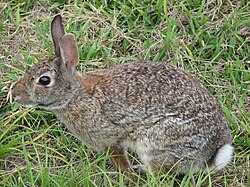
The lagomorphs comprise two families, Leporidae (hares and rabbits), and Ochotonidae (pikas). Though they can resemble rodents, and were classified as a superfamily in that order until the early 20th century, they have since been considered a separate order. They differ from rodents in a number of physical characteristics, such as having four incisors in the upper jaw rather than two. South America's meager lagomorph diversity (6 species compared to 18 for North America north of Mexico) reflects their recent arrival and failure (so far) to diversify much. Only the tapeti is present south of northern South America; lagomorphs are absent from most of South America's southern cone.
- Family: Leporidae (rabbits, hares)
- Genus: Sylvilagus
- Andean cottontail, Sylvilagus andinusNE
- Tapeti, Sylvilagus brasiliensis LC
- Eastern cottontail, Sylvilagus floridanus LC
- Suriname lowland forest cottontail, Sylvilagus parentumNE
- Rio de Janeiro dwarf rabbit, Sylvilagus tapetillusNE
- Venezuelan lowland rabbit, Sylvilagus varynaensisDD
- Genus: Sylvilagus
Superorder: Laurasiatheria
Order: Eulipotyphla (shrews, hedgehogs, moles, and solenodons)
Eulipotyphlans are insectivorous mammals. Shrews and solenodons closely resemble mice, hedgehogs carry spines, while moles are stout-bodied burrowers. In South America, shrews are only found in the north (Colombia, Venezuela, Ecuador and Peru), a legacy of their relatively recent immigration to the continent by way of Central America (where shrew species are considerably more diverse). Moles are not found in the Americas south of northern Mexico.
- Family: Soricidae (shrews)
- Subfamily: Soricinae
- Tribe: Blarinini
- Genus: Cryptotis
- C. nigrescens group
- Eastern Cordillera small-footed shrew, Cryptotis brachyonyxDD
- Colombian small-eared shrew, Cryptotis colombiana LC
- Darién small-eared shrew, Cryptotis meraEN
- C. thomasi group
- Ecuadoran small-eared shrew, Cryptotis equatoris LC
- Medellín small-eared shrew, Cryptotis medellinia LC
- Merida small-eared shrew, Cryptotis meridensis LC
- Wandering small-eared shrew, Cryptotis montivaga LC
- Peruvian small-eared shrew, Cryptotis peruviensisDD
- Scaly-footed small-eared shrew, Cryptotis squamipes LC
- Tamá small-eared shrew, Cryptotis tamensis LC
- Thomas' small-eared shrew, Cryptotis thomasi LC
- C. nigrescens group
- Genus: Cryptotis
- Tribe: Blarinini
- Subfamily: Soricinae
Order: Chiroptera (bats)




The bats' most distinguishing feature is that their forelimbs are developed as wings, making them the only mammals capable of flight. Bat species account for about 20% of all mammals.
- Family: Noctilionidae (bulldog bats)
- Genus: Noctilio
- Lesser bulldog bat, Noctilio albiventris LC
- Greater bulldog bat, Noctilio leporinus LC
- Genus: Noctilio
- Family: Vespertilionidae
- Subfamily: Myotinae
- Genus: Myotis
- Southern myotis, Myotis aelleniDD
- Silver-tipped myotis, Myotis albescens LC
- Atacama myotis, Myotis atacamensisNT
- Chilean myotis, Myotis chiloensis LC
- Myotis dinellii LC
- Hairy-legged myotis, Myotis keaysi LC
- Yellowish myotis, Myotis levis LC
- Myotis midastactus NE
- Curacao myotis, Myotis nesopolus LC
- Black myotis, Myotis nigricans LC
- Montane myotis, Myotis oxyotus LC
- Riparian myotis, Myotis riparius LC
- Red myotis, Myotis ruberNT
- Velvety myotis, Myotis simusDD
- Genus: Myotis
- Subfamily: Vespertilioninae
- Genus: Eptesicus
- Little black serotine, Eptesicus andinus LC
- Brazilian brown bat, Eptesicus brasiliensis LC
- Chiriquinan serotine, Eptesicus chiriquinus LC
- Diminutive serotine, Eptesicus diminutusDD
- Argentine brown bat, Eptesicus furinalis LC
- Big brown bat, Eptesicus fuscus LC
- Harmless serotine, Eptesicus innoxiusNT
- Eptesicus taddeii
- Genus: Histiotus
- Strange big-eared brown bat, Histiotus alienusDD
- Humboldt big-eared brown bat, Histiotus humboldtiDD
- Thomas's big-eared brown bat, Histiotus laephotisNT
- Big-eared brown bat, Histiotus macrotus LC
- Southern big-eared brown bat, Histiotus magellanicus LC
- Small big-eared brown bat, Histiotus montanus LC
- Tropical big-eared brown bat, Histiotus velatusDD
- Genus: Lasiurus
- Lasiurus atratus LC
- Desert red bat, Lasiurus blossevillii LC
- Tacarcuna bat, Lasiurus castaneusDD
- Hoary bat, Lasiurus cinereus LC
- Hairy-tailed bat, Lasiurus ebenusDD
- Southern yellow bat, Lasiurus ega LC
- Big red bat, Lasiurus egregiusDD
- Pfeiffer's red bat, Lasiurus pfeifferi
- Saline red bat, Lasiurus salinae
- Cinnamon red bat, Lasiurus varius LC
- Genus: Rhogeessa
- Husson's yellow bat, Rhogeessa hussoniDD
- Thomas's yellow bat, Rhogeessa io LC
- Tiny yellow bat, Rhogeessa minutillaVU
- Genus: Eptesicus
- Subfamily: Tomopeatinae
- Genus: Tomopeas
- Blunt-eared bat, Tomopeas ravusVU
- Genus: Tomopeas
- Subfamily: Myotinae

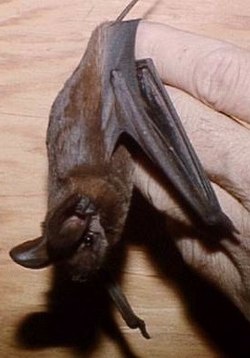


- Family: Molossidae (free-tailed bats)
- Genus: Cynomops
- Cinnamon dog-faced bat, Cynomops abrasusDD
- Greenhall's dog-faced bat, Cynomops greenhalli LC
- Para dog-faced bat, Cynomops paranusDD
- Southern dog-faced bat, Cynomops planirostris LC
- Genus: Eumops
- Black bonneted bat, Eumops auripendulus LC
- Dwarf bonneted bat, Eumops bonariensis LC
- Big bonneted bat, Eumops dabbenei LC
- Wagner's bonneted bat, Eumops glaucinus LC
- Sanborn's bonneted bat, Eumops hansae LC
- Guianan bonneted bat, Eumops maurusDD
- Patagonian bonneted bat, Eumops patagonicus LC
- Western mastiff bat, Eumops perotis LC
- Colombian bonneted bat, Eumops trumbulli LC
- Wilson's bonneted bat, Eumops wilsoni
- Genus: Molossops
- Equatorial dog-faced bat, Molossops aequatorianusVU
- Mato Grosso dog-faced bat, Molossops mattogrossensis LC
- Rufous dog-faced bat, Molossops neglectusDD
- Dwarf dog-faced bat, Molossops temminckii LC
- Genus: Molossus
- Barnes's mastiff bat, Molossus barnesiDD
- Coiban mastiff bat, Molossus coibensis LC
- Bonda mastiff bat, Molossus currentium LC
- Velvety free-tailed bat, Molossus molossus LC
- Miller's mastiff bat, Molossus pretiosus LC
- Black mastiff bat, Molossus rufus LC
- Sinaloan mastiff bat, Molossus sinaloae LC
- Molossus trinitatis
- Genus: Mormopterus
- Kalinowski's mastiff bat, Mormopterus kalinowskii LC
- Incan little mastiff bat, Mormopterus phrudusVU
- Genus: Nyctinomops
- Peale's free-tailed bat, Nyctinomops aurispinosus LC
- Broad-eared bat, Nyctinomops laticaudatus LC
- Big free-tailed bat, Nyctinomops macrotis LC
- Genus: Promops
- Big crested mastiff bat, Promops centralis LC
- Brown mastiff bat, Promops nasutus LC
- Genus: Tadarida
- Mexican free-tailed bat, Tadarida brasiliensis LC
- Genus: Cynomops
- Family: Emballonuridae (ghost bats, sac-winged bats and allies)
- Genus: Balantiopteryx
- Ecuadorian sac-winged bat, Balantiopteryx infuscaEN
- Gray sac-winged bat, Balantiopteryx plicata LC
- Genus: Centronycteris
- Thomas's shaggy bat, Centronycteris centralis LC
- Shaggy bat, Centronycteris maximiliani LC
- Genus: Cormura
- Chestnut sac-winged bat, Cormura brevirostris LC
- Genus: Cyttarops
- Short-eared bat, Cyttarops alecto LC
- Genus: Diclidurus
- Northern ghost bat, Diclidurus albus LC
- Greater ghost bat, Diclidurus ingensDD
- Isabelle's ghost bat, Diclidurus isabella LC
- Lesser ghost bat, Diclidurus scutatus LC
- Genus: Peropteryx
- Greater dog-like bat, Peropteryx kappleri LC
- White-winged dog-like bat, Peropteryx leucoptera LC
- Lesser doglike bat, Peropteryx macrotis LC
- Trinidad dog-like bat, Peropteryx trinitatisDD
- Pale-winged dog-like bat, Peropteryx pallidoptera
- Genus: Rhynchonycteris
- Proboscis bat, Rhynchonycteris naso LC
- Genus: Saccopteryx
- Antioquian sac-winged bat, Saccopteryx antioquensisDD
- Greater sac-winged bat, Saccopteryx bilineata LC
- Frosted sac-winged bat, Saccopteryx canescens LC
- Amazonian sac-winged bat, Saccopteryx gymnuraDD
- Lesser sac-winged bat, Saccopteryx leptura LC
- Genus: Balantiopteryx

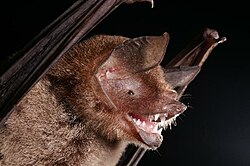
- Family: Mormoopidae (mustached bats)
- Genus: Mormoops
- Ghost-faced bat, Mormoops megalophylla LC
- Genus: Pteronotus
- Davy's naked-backed bat, Pteronotus davyi LC
- Big naked-backed bat, Pteronotus gymnonotus LC
- Paraguana moustached bat, Pteronotus paraguanensisEN
- Parnell's mustached bat, Pteronotus parnellii LC
- Wagner's mustached bat, Pteronotus personatus LC
- Genus: Mormoops

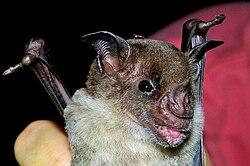
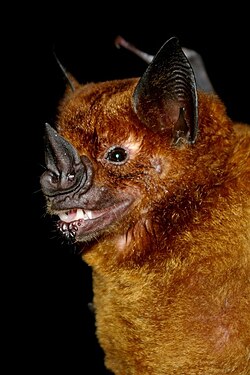




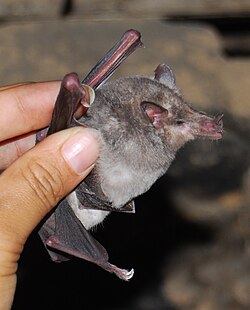









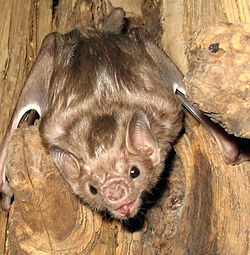

- Family: Phyllostomidae (leaf-nosed bats)
- Subfamily: Phyllostominae
- Genus: Chrotopterus
- Big-eared woolly bat, Chrotopterus auritus LC
- Genus: Glyphonycteris
- Behn's bat, Glyphonycteris behniiDD
- Davies's big-eared bat, Glyphonycteris daviesi LC
- Tricolored big-eared bat, Glyphonycteris sylvestris LC
- Genus: Lampronycteris
- Yellow-throated big-eared bat, Lampronycteris brachyotis LC
- Genus: Lonchorhina
- Tomes's sword-nosed bat, Lonchorhina aurita LC
- Fernandez's sword-nosed bat, Lonchorhina fernandeziEN
- Northern sword-nosed bat, Lonchorhina inusitataDD
- Marinkelle's sword-nosed bat, Lonchorhina marinkelleiEN
- Orinoco sword-nosed bat, Lonchorhina orinocensisVU
- Genus: Lophostoma
- Lophostoma aequatorialis DD
- Pygmy round-eared bat, Lophostoma brasiliense LC
- Carriker's round-eared bat, Lophostoma carrikeri LC
- Schultz's round-eared bat, Lophostoma schulzi LC
- White-throated round-eared bat, Lophostoma silvicolum LC
- Lophostoma yasuni DD
- Genus: Macrophyllum
- Long-legged bat, Macrophyllum macrophyllum LC
- Genus: Micronycteris
- Brosset's big-eared bat, Micronycteris brossetiDD
- Micronycteris giovanniae
- Hairy big-eared bat, Micronycteris hirsuta LC
- Pirlot's big-eared bat, Micronycteris homezi
- Matses' big-eared bat, Micronycteris matsesDD
- Little big-eared bat, Micronycteris megalotis LC
- Common big-eared bat, Micronycteris microtis LC
- White-bellied big-eared bat, Micronycteris minuta LC
- Sanborn's big-eared bat, Micronycteris sanborniDD
- Schmidts's big-eared bat, Micronycteris schmidtorum LC
- Genus: Mimon
- Golden bat, Mimon bennettii LC
- Cozumelan golden bat, Mimon cozumelae LC
- Striped hairy-nosed bat, Mimon crenulatum LC
- Koepcke's hairy-nosed bat, Mimon koepckeaeDD
- Genus: Neonycteris
- Least big-eared bat, Neonycteris pusillaVU
- Genus: Phylloderma
- Pale-faced bat, Phylloderma stenops LC
- Genus: Phyllostomus
- Pale spear-nosed bat, Phyllostomus discolor LC
- Lesser spear-nosed bat, Phyllostomus elongatus LC
- Greater spear-nosed bat, Phyllostomus hastatus LC
- Guianan spear-nosed bat, Phyllostomus latifolius LC
- Genus: Tonatia
- Greater round-eared bat, Tonatia bidensDD
- Stripe-headed round-eared bat, Tonatia saurophila LC
- Genus: Trachops
- Fringe-lipped bat, Trachops cirrhosus LC
- Genus: Trinycteris
- Niceforo's big-eared bat, Trinycteris nicefori LC
- Genus: Vampyrum
- Spectral bat, Vampyrum spectrumNT
- Genus: Chrotopterus
- Subfamily: Glossophaginae
- Genus: Anoura
- Anoura aequatoris
- Cadena's tailless bat, Anoura cadenai
- Tailed tailless bat, Anoura caudifer LC
- Handley's tailless bat, Anoura cultrataNT
- Tube-lipped nectar bat, Anoura fistulataDD
- Geoffroy's tailless bat, Anoura geoffroyi LC
- Broad-toothed tailless bat, Anoura latidens LC
- Luis Manuel's tailless bat, Anoura luismanueli LC
- Genus: Choeroniscus
- Godman's long-tailed bat, Choeroniscus godmani LC
- Minor long-nosed long-tongued bat, Choeroniscus minor LC
- Greater long-tailed bat, Choeroniscus periosusVU
- Genus: Glossophaga
- Commissaris's long-tongued bat, Glossophaga commissarisi LC
- Miller's long-tongued bat, Glossophaga longirostrisDD
- Pallas's long-tongued bat, Glossophaga soricina LC
- Genus: Leptonycteris
- Southern long-nosed bat, Leptonycteris curasoaeVU
- Genus: Lichonycteris
- Dark long-tongued bat, Lichonycteris obscura LC
- Genus: Lionycteris
- Chestnut long-tongued bat, Lionycteris spurrelli LC
- Genus: Lonchophylla
- Bokermann's nectar bat, Lonchophylla bokermanniDD
- Lonchophylla cadenai
- Chocoan long-tongued bat, Lonchophylla chocoanaDD
- Goldman's nectar bat, Lonchophylla concavaNT
- Dekeyser's nectar bat, Lonchophylla dekeyseriNT
- Lonchophylla fornicata
- Handley's nectar bat, Lonchophylla handleyi LC
- Western nectar bat, Lonchophylla hesperiaVU
- Godman's nectar bat, Lonchophylla mordax LC
- Orcés's long-tongued bat, Lonchophylla orcesiDD
- Lonchophylla pattoni
- Orange nectar bat, Lonchophylla robusta LC
- Thomas's nectar bat, Lonchophylla thomasi LC
- Genus: Platalina
- Long-snouted bat, Platalina genovensiumNT
- Genus: Scleronycteris
- Ega long-tongued bat, Scleronycteris ega LC
- Genus: Anoura
- Subfamily: Carolliinae
- Genus: Carollia
- Benkeith's short-tailed bat, Carollia benkeithi
- Silky short-tailed bat, Carollia brevicauda LC
- Chestnut short-tailed bat, Carollia castanea LC
- Colombian short-tailed bat, Carollia colombiana
- Manu short-tailed bat, Carollia manu LC
- Mono's short-tailed bat, Carollia monohernandezi
- Seba's short-tailed bat, Carollia perspicillata LC
- Genus: Rhinophylla
- Hairy little fruit bat, Rhinophylla alethinaNT
- Fischer's little fruit bat, Rhinophylla fischerae LC
- Dwarf little fruit bat, Rhinophylla pumilio LC
- Genus: Carollia
- Subfamily: Stenodermatinae
- Genus: Ametrida
- Little white-shouldered bat, Ametrida centurio LC
- Genus: Artibeus
- Large fruit-eating bat, Artibeus amplus LC
- Brown fruit-eating bat, Artibeus concolor LC
- Fringed fruit-eating bat, Artibeus fimbriatus LC
- Fraternal fruit-eating bat, Artibeus fraterculus LC
- Jamaican fruit bat, Artibeus jamaicensis LC
- Great fruit-eating bat, Artibeus lituratus LC
- Dark fruit-eating bat, Artibeus obscurus LC
- Flat-faced fruit-eating bat, Artibeus planirostris LC
- Genus: Centurio
- Wrinkle-faced bat, Centurio senex LC
- Genus: Chiroderma
- Brazilian big-eyed bat, Chiroderma doriae LC
- Salvin's big-eyed bat, Chiroderma salvini LC
- Little big-eyed bat, Chiroderma trinitatum LC
- Hairy big-eyed bat, Chiroderma villosum LC
- Genus: Dermanura
- Andersen's fruit-eating bat, Dermanura anderseni LC
- Bogota fruit-eating bat, Dermanura bogotensis LC
- Gervais's fruit-eating bat, Dermanura cinerea LC
- Silver fruit-eating bat, Dermanura glauca LC
- Gnome fruit-eating bat, Dermanura gnoma LC
- Pygmy fruit-eating bat, Dermanura phaeotis LC
- Dermanura rava NE
- Rosenberg's fruit-eating bat, Dermanura rosenbergiDD
- Toltec fruit-eating bat, Dermanura tolteca LC
- Thomas's fruit-eating bat, Dermanura watsoni LC
- Genus: Enchisthenes
- Velvety fruit-eating bat, Enchisthenes hartii LC
- Genus: Mesophylla
- MacConnell's bat, Mesophylla macconnelli LC
- Genus: Platyrrhinus
- Alberico's broad-nosed bat, Platyrrhinus alberico LC
- Slender broad-nosed bat, Platyrrhinus angustirostris
- Platyrrhinus aquilus
- Eldorado broad-nosed bat, Platyrrhinus aurarius LC
- Short-headed broad-nosed bat, Platyrrhinus brachycephalus LC
- Choco broad-nosed bat, Platyrrhinus chocoensisEN
- Thomas's broad-nosed bat, Platyrrhinus dorsalis LC
- Brown-bellied broad-nosed bat, Platyrrhinus fusciventris
- Heller's broad-nosed bat, Platyrrhinus helleri LC
- Platyrrhinus incarum
- Buffy broad-nosed bat, Platyrrhinus infuscus LC
- Ismael's broad-nosed bat, Platyrrhinus ismaeli VU
- White-lined broad-nosed bat, Platyrrhinus lineatus LC
- Quechua broad-nosed bat, Platyrrhinus masu LC
- Matapalo broad-nosed bat, Platyrrhinus matapalensisNT
- Geoffroy's rayed bat, Platyrrhinus nigellus LC
- Platyrrhinus nitelinea
- Recife broad-nosed bat, Platyrrhinus recifinus LC
- Shadowy broad-nosed bat, Platyrrhinus umbratusDD
- Greater broad-nosed bat, Platyrrhinus vittatus LC
- Genus: Sphaeronycteris
- Visored bat, Sphaeronycteris toxophyllumDD
- Genus: Pygoderma
- Ipanema bat, Pygoderma bilabiatum LC
- Genus: Sturnira
- Aratathomas's yellow-shouldered bat, Sturnira aratathomasiNT
- Bidentate yellow-shouldered bat, Sturnira bidens LC
- Bogota yellow-shouldered bat, Sturnira bogotensis LC
- Hairy yellow-shouldered bat, Sturnira erythromos LC
- Chocó yellow-shouldered bat, Sturnira koopmanhilli
- Little yellow-shouldered bat, Sturnira lilium LC
- Highland yellow-shouldered bat, Sturnira ludovici LC
- Louis's yellow-shouldered bat, Sturnira luisi LC
- Greater yellow-shouldered bat, Sturnira magna LC
- Mistratoan yellow-shouldered bat, Sturnira mistratensisDD
- Talamancan yellow-shouldered bat, Sturnira mordaxNT
- Lesser yellow-shouldered bat, Sturnira nanaEN
- Tschudi's yellow-shouldered bat, Sturnira oporaphilumNT
- Soriano's yellow-shouldered bat, Sturnira sorianoiDD
- Tilda's yellow-shouldered bat, Sturnira tildae LC
- Genus: Uroderma
- Tent-making bat, Uroderma bilobatum LC
- Brown tent-making bat, Uroderma magnirostrum LC
- Genus: Vampyressa
- Bidentate yellow-eared bat, Vampyressa bidens LC
- Brock's yellow-eared bat, Vampyressa brocki LC
- Melissa's yellow-eared bat, Vampyressa melissaVU
- Striped yellow-eared bat, Vampyressa nymphaea LC
- Southern little yellow-eared bat, Vampyressa pusillaDD
- Northern little yellow-eared bat, Vampyressa thyone LC
- Genus: Vampyrodes
- Great stripe-faced bat, Vampyrodes caraccioli LC
- Genus: Ametrida
- Subfamily: Desmodontinae
- Genus: Desmodus
- Common vampire bat, Desmodus rotundus LC
- Genus: Diaemus
- White-winged vampire bat, Diaemus youngi LC
- Genus: Diphylla
- Hairy-legged vampire bat, Diphylla ecaudata LC
- Genus: Desmodus
- Subfamily: Phyllostominae
- Family: Natalidae (funnel-eared bats)
- Genus: Chilonatalus
- Cuban funnel-eared bat, Chilonatalus micropusNT
- Genus: Natalus
- Brazilian funnel-eared bat, Natalus espiritosantensisNT
- Trinidadian funnel-eared bat, Natalus tumidirostris LC
- Genus: Chilonatalus
- Family: Furipteridae (thumbless bats)
- Genus: Amorphochilus
- Smoky bat, Amorphochilus schnabliiEN
- Genus: Furipterus
- Thumbless bat, Furipterus horrens LC
- Genus: Amorphochilus
- Family: Thyropteridae (disc-winged bats)
- Genus: Thyroptera
- Peters's disk-winged bat, Thyroptera discifera LC
- de Vivo's disk-winged bat, Thyroptera devivoiDD
- LaVal's disk-winged bat, Thyroptera lavaliDD
- Spix's disk-winged bat, Thyroptera tricolor LC
- Genus: Thyroptera
Order: Carnivora (carnivorans)
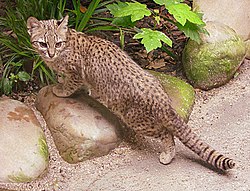


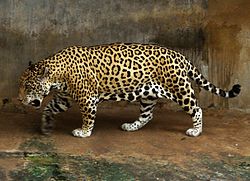










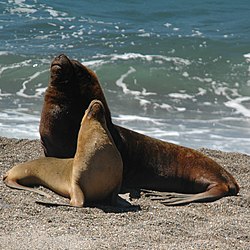
There are over 260 species of carnivorans, the majority of which feed primarily on meat. They have a characteristic skull shape and dentition. South America is notable for its diversity of canids, having more genera than any other continent in spite of their relatively brief history there. South America's felid diversity is also greater than that of North America north of Mexico, while its mustelid diversity is comparable and its mephitid and ursid diversities are lower. Its procyonid diversity is somewhat less than that of Central America, the center of the family's recent evolution. The diversification of canids and felids in South America was partly a consequence of the inability of the continent's native avian and metatherian predators to compete effectively following the Great American Interchange.
- Suborder: Feliformia
- Family: Felidae (cats)
- Subfamily: Felinae
- Genus: Herpailurus
- Jaguarundi, Herpailurus yagouaroundi LC
- Genus: Puma
- Cougar, Puma concolor LC
- Genus: Leopardus
- Pampas cat, Leopardus colocoloNT
- Geoffroy's cat, Leopardus geoffroyi LC
- Kodkod, Leopardus guignaVU
- Southern tigrina, Leopardus guttulusVU
- Andean mountain cat, Leopardus jacobitaEN
- Ocelot, Leopardus pardalis LC
- Oncilla, Leopardus tigrinusVU
- Margay, Leopardus wiediiNT
- Genus: Herpailurus
- Subfamily: Pantherinae
- Subfamily: Felinae
- Family: Felidae (cats)
- Suborder: Caniformia
- Family: Canidae (dogs, foxes)
- Genus: Lycalopex
- Culpeo, Lycalopex culpaeus LC
- Darwin's fox, Lycalopex fulvipesEN
- South American gray fox, Lycalopex griseus LC
- Pampas fox, Lycalopex gymnocercus LC
- Sechuran fox, Lycalopex sechuraeNT
- Hoary fox, Lycalopex vetulus LC
- Genus: Cerdocyon
- Crab-eating fox, Cerdocyon thous LC
- Genus: Atelocynus
- Short-eared dog, Atelocynus microtisNT
- Genus: Speothos
- Bush dog, Speothos venaticusNT
- Genus: Chrysocyon
- Maned wolf, Chrysocyon brachyurusNT
- Genus: Urocyon
- Gray fox, Urocyon cinereoargenteus LC
- Genus: Lycalopex
- Family: Ursidae (bears)
- Genus: Tremarctos
- Spectacled bear, Tremarctos ornatusVU
- Genus: Tremarctos
- Family: Procyonidae (raccoons, coatis and allies)
- Genus: Procyon
- Crab-eating raccoon, Procyon cancrivorus LC
- Genus: Nasua
- White-nosed coati, Nasua narica LC
- South American coati, Nasua nasua LC
- Genus: Nasuella
- Eastern mountain coati, Nasuella meridensisEN
- Western mountain coati, Nasuella olivaceaNT
- Genus: Potos
- Kinkajou, Potos flavus LC
- Genus: Bassaricyon
- Eastern lowland olingo, Bassaricyon alleni LC
- Western lowland olingo, Bassaricyon medius LC
- Olinguito, Bassaricyon neblinaNT
- Genus: Procyon
- Family: Mustelidae (weasels, otters)
- Genus: Neogale
- Amazon weasel, Neogale africana LC
- Colombian weasel, Neogale felipeiVU
- Long-tailed weasel, Neogale frenata LC
- Genus: Eira
- Tayra, Eira barbara LC
- Genus: Galictis
- Lesser grison, Galictis cuja LC
- Greater grison, Galictis vittata LC
- Genus: Lyncodon
- Patagonian weasel, Lyncodon patagonicus LC
- Genus: Lontra
- Marine otter, Lontra felinaEN
- Neotropical river otter, Lontra longicaudisNT
- Southern river otter, Lontra provocaxEN
- Genus: Pteronura
- Giant otter, Pteronura brasiliensisEN
- Genus: Neogale
- Family: Mephitidae (skunks)
- Genus: Conepatus
- Molina's hog-nosed skunk, Conepatus chinga LC
- Humboldt's hog-nosed skunk, Conepatus humboldtii LC
- Striped hog-nosed skunk, Conepatus semistriatus LC
- Genus: Conepatus
- Clade: Pinnipedia (seals, sea lions and walruses)
- Family: Otariidae (eared seals, sea lions)
- Genus: Arctocephalus
- South American fur seal, Arctocephalus australis LC
- Galápagos fur seal, Arctocephalus galapagoensisEN
- Antarctic fur seal, Arctocephalus gazella LC
- Juan Fernández fur seal, Arctocephalus philippii LC
- Subantarctic fur seal, Arctocephalus tropicalis LC
- Genus: Otaria
- South American sea lion, Otaria flavescens LC
- Genus: Zalophus
- Galápagos sea lion, Zalophus wollebaekiEN
- Genus: Arctocephalus
- Family: Phocidae (earless seals)
- Genus: Hydrurga
- Leopard seal, Hydrurga leptonyx LC
- Genus: Leptonychotes
- Weddell seal, Leptonychotes weddellii LC
- Genus: Lobodon
- Crabeater seal, Lobodon carcinophaga LC
- Genus: Mirounga
- Southern elephant seal, Mirounga leonina LC
- Genus: Hydrurga
- Family: Otariidae (eared seals, sea lions)
- Family: Canidae (dogs, foxes)
Order: Perissodactyla (odd-toed ungulates)

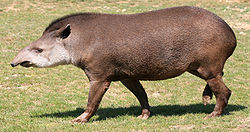
The odd-toed ungulates are browsing and grazing mammals. They are usually large to very large, and have relatively simple stomachs and a large middle toe. Following the interchange with North America, South America's odd-toed ungulates included equids of genus Equus as well as tapirs. Equids died out in both North and South America around the time of the first arrival of humans, while tapirs died out in most of North America but survived in Central and South America. South America also once had a great diversity of ungulates of native origin, but these dwindled after the interchange with North America, and disappeared entirely following the arrival of humans. Sequencing of collagen from fossils of one recently extinct species each of notoungulates and litopterns has indicated that these orders comprise a sister group to the perissodactyls. [13] If, as some evidence suggests, perissodactyls originated in India, [14] both ungulate groups may have been of Gondwanan origin, despite being laurasiatheres.
- Family: Tapiridae (tapirs)
- Genus: Tapirus
- Baird's tapir, Tapirus bairdiiEN
- Mountain tapir, Tapirus pinchaqueEN
- Lowland tapir, Tapirus terrestrisVU
- Genus: Tapirus
Order: Artiodactyla (even-toed ungulates and cetaceans)
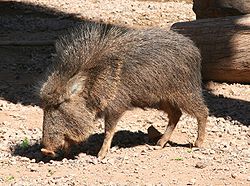


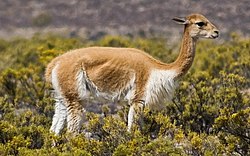
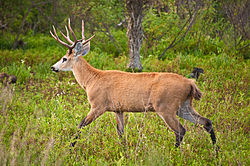
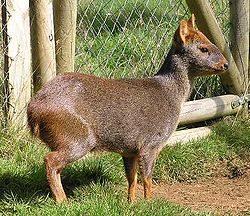
The weight of even-toed ungulates is borne about equally by the third and fourth toes, rather than mostly or entirely by the third as in perissodactyls. There are about 220 noncetacean artiodactyl species, including many that are of great economic importance to humans. South America's considerable cervid diversity belies their relatively recent arrival. The presence of camelids in South America but not North America today is ironic, given that they have a 45-million-year-long history in the latter continent (where they originated), and only a 3-million-year history in the former.
- Family: Tayassuidae (peccaries)
- Genus: Catagonus
- Chacoan peccary, Catagonus wagneriEN
- Genus: Dicotyles
- Collared peccary, Dicotyles tajacu LC
- Genus: Tayassu
- White-lipped peccary, Tayassu pecariVU
- Genus: Catagonus
- Family: Camelidae (camels, llamas)
- Family: Cervidae (deer)
- Subfamily: Capreolinae
- Genus: Blastocerus
- Marsh deer, Blastocerus dichotomusVU
- Genus: Hippocamelus
- Taruca, Hippocamelus antisensisVU
- South Andean deer, Hippocamelus bisulcusEN
- Genus: Mazama
- Red brocket, Mazama americanaDD
- Small red brocket, Mazama bororoVU
- Merida brocket, Mazama briceniiVU
- Dwarf brocket, Mazama chunyiVU
- Gray brocket, Mazama gouazoupira LC
- Pygmy brocket, Mazama nanaVU
- Amazonian brown brocket, Mazama nemorivaga LC
- Little red brocket, Mazama rufinaVU
- Central American red brocket, Mazama temamaDD
- Genus: Odocoileus
- White-tailed deer, Odocoileus virginianus LC
- Genus: Ozotoceros
- Pampas deer, Ozotoceros bezoarticusNT
- Genus: Pudú
- Northern pudú, Pudu mephistophilesVU
- Southern pudú, Pudu pudaNT
- Genus: Blastocerus
- Subfamily: Cervinae
- Genus: Dama
- European fallow deer, D. dama LC introduced [15]
- Genus: Dama
- Subfamily: Capreolinae
Infraorder: Cetacea (whales, dolphins and porpoises)



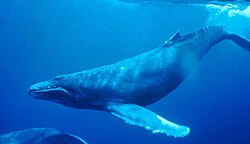


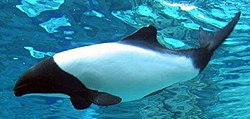
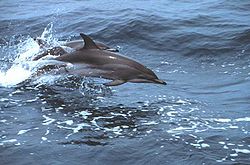





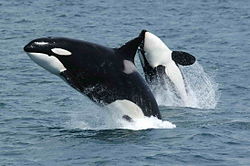


The infraorder Cetacea includes whales, dolphins and porpoises. They are the mammals most fully adapted to aquatic life with a spindle-shaped nearly hairless body, protected by a thick layer of blubber, and forelimbs and tail modified to provide propulsion underwater. Their closest extant relatives are the hippos, which are artiodactyls, from which cetaceans descended; cetaceans are thus also artiodactyls.
- Parvorder: Mysticeti
- Family: Balaenidae (right whales)
- Genus: Eubalaena
- Southern right whale, Eubalaena australis LC
- Genus: Eubalaena
- Family: Balaenopteridae (rorquals)
- Subfamily: Balaenopterinae
- Genus: Balaenoptera
- Common minke whale, Balaenoptera acutorostrata LC
- Antarctic minke whale, Balaenoptera bonaerensisNT
- Sei whale, Balaenoptera borealisEN
- Bryde's whale, Balaenoptera brydeiNE
- Blue whale, Balaenoptera musculusEN
- Fin whale, Balaenoptera physalusVU
- Genus: Balaenoptera
- Subfamily: Megapterinae
- Genus: Megaptera
- Humpback whale, Megaptera novaeangliae LC
- Genus: Megaptera
- Subfamily: Balaenopterinae
- Family: Neobalaenidae
- Genus: Caperea
- Pygmy right whale, Caperea marginata LC
- Genus: Caperea
- Family: Balaenidae (right whales)
- Parvorder: Odontoceti
- Family: Physeteridae (sperm whales)
- Genus: Physeter
- Sperm whale, Physeter macrocephalusVU
- Genus: Physeter
- Family: Kogiidae (pygmy, dwarf sperm whales)
- Genus: Kogia
- Pygmy sperm whale, Kogia brevicepsDD
- Dwarf sperm whale, Kogia simaDD
- Genus: Kogia
- Family: Ziphidae (beaked whales)
- Genus: Ziphius
- Cuvier's beaked whale, Ziphius cavirostris LC
- Genus: Berardius
- Arnoux's beaked whale, Berardius arnuxiiDD
- Genus: Tasmacetus
- Shepherd's beaked whale, Tasmacetus shepherdiDD
- Subfamily: Hyperoodontinae
- Genus: Hyperoodon
- Southern bottlenose whale, Hyperoodon planifrons LC
- Genus: Mesoplodon
- Andrews' beaked whale, Mesoplodon bowdoiniDD
- Blainville's beaked whale, Mesoplodon densirostrisDD
- Gervais' beaked whale, Mesoplodon europaeusDD
- Ginkgo-toothed beaked whale, Mesoplodon ginkgodensDD
- Gray's beaked whale, Mesoplodon grayiDD
- Hector's beaked whale, Mesoplodon hectoriDD
- Strap-toothed whale, Mesoplodon layardiiDD
- Pygmy beaked whale, Mesoplodon peruvianusDD
- Spade-toothed whale, Mesoplodon traversiiDD
- Genus: Hyperoodon
- Genus: Ziphius
- Superfamily: Inioidea (river dolphins)
- Family: Iniidae
- Genus: Inia
- Araguaian river dolphin, Inia araguaiaensis
- Amazon river dolphin, Inia geoffrensisEN
- Bolivian river dolphin, Inia geoffrensis boliviensis
- Genus: Inia
- Family: Pontoporiidae
- Genus: Pontoporia
- La Plata dolphin, Pontoporia blainvilleiVU
- Genus: Pontoporia
- Family: Iniidae
- Superfamily: Delphinoidea
- Family: Phocoenidae (porpoises)
- Genus: Phocoena
- Spectacled porpoise, Phocoena dioptrica LC
- Burmeister's porpoise, Phocoena spinipinnisNT
- Genus: Phocoena
- Family: Delphinidae (marine dolphins)
- Genus: Cephalorhynchus
- Commerson's dolphin, Cephalorhynchus commersonii LC
- Chilean dolphin, Cephalorhynchus eutropiaNT
- Genus: Steno
- Rough-toothed dolphin, Steno bredanensis LC
- Genus: Sotalia
- Tucuxi, Sotalia fluviatilisDD
- Guiana dolphin, Sotalia guianensisNT
- Genus: Tursiops
- Common bottlenose dolphin, Tursiops truncatus LC
- Genus: Stenella
- Pantropical spotted dolphin, Stenella attenuata LC
- Clymene dolphin, Stenella clymene LC
- Striped dolphin, Stenella coeruleoalba LC
- Atlantic spotted dolphin, Stenella frontalis LC
- Spinner dolphin, Stenella longirostris LC
- Genus: Delphinus
- Long-beaked common dolphin, Delphinus capensisDD
- Short-beaked common dolphin, Delphinus delphis LC
- Genus: Lagenodelphis
- Fraser's dolphin, Lagenodelphis hosei LC
- Genus: Lagenorhynchus
- Peale's dolphin, Lagenorhynchus australisDD
- Hourglass dolphin, Lagenorhynchus cruciger LC
- Dusky dolphin, Lagenorhynchus obscurusDD
- Genus: Lissodelphis
- Southern right whale dolphin, Lissodelphis peronii LC
- Genus: Grampus
- Risso's dolphin, Grampus griseus LC
- Genus: Feresa
- Pygmy killer whale, Feresa attenuata LC
- Genus: Orcinus
- Orca, Orcinus orcaDD
- Genus: Pseudorca
- False killer whale, Pseudorca crassidensNT
- Genus: Globicephala
- Short-finned pilot whale, Globicephala macrorhynchus LC
- Long-finned pilot whale, Globicephala melas LC
- Genus: Peponocephala
- Melon-headed whale, Peponocephala electra LC
- Genus: Cephalorhynchus
- Family: Phocoenidae (porpoises)
- Family: Physeteridae (sperm whales)